
PRSRT STD U.S. POSTAGE PAID BOLINGBROOK, IL PERMIT NO. 323 | YOUR SOURCE FOR MEXICAN AND LATIN FOODSERVICE TRENDS | www.elrestaurante.com | JULY/AUGUST 2023 Taking Cocktail Flights to New Heights Growing a Family Business FLAN DE VAINILLA ‘CARMENCITA’ COCINA AL FONDO SAN JUAN, PUERTO RICO Desserts that DELIGHT







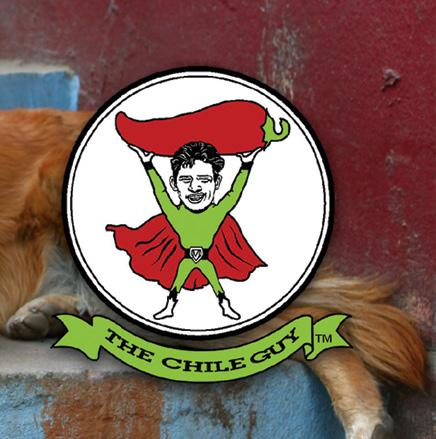




Dehydrated Chile doesn’t care what time of the year it is! You can also call (800) 869-9218 or (505) 867-4251 to place an order. www.thechileguy.com You can also call (800) 869-9218 or (505) 867-4251 to place an order. www.thechileguy.com


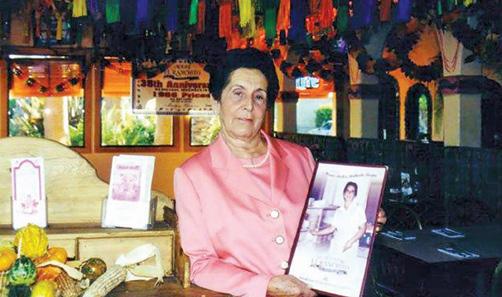





elRestaurante | YOUR SOURCE FOR MEXICAN AND LATIN FOODSERVICE TRENDS | www.elrestaurante.com | In This Issue 20 ON THE WEB AT www.elrestaurante.com Read more news and find more recipes on our NEW AND IMPROVED WEBSITE! 6 HOTLINE 16 FIVE QUESTIONS — Chef Juan J. Sanjuan III, Gloria’s 20 COVER STORY: Desserts that Delight By Annelise Kelly; cover photo courtesy of Cocina Al Fondo 29 SNAPSHOT — Healthy Substance 34 IMMIGRANT STORIES Soleil Ramírez (in English and Spanish) 40 AT THE BAR — Taking Cocktail Flights to New Heights (In English and Spanish) 49 BUSINESS BASICS — Guidelines for Growing a Family Business (In English and Spanish) 54 FROM MEXICO — Cocina Mexicana: Creating Food that Tells a Story (In English and Spanish) 59 MARKETPLACE (In English and Spanish) 63 RECIPES 64 MY FAVORITE RECIPE 29 40 49
I don’t think there’s a single person I’ve spoken with recently who isn’t at some level both exhausted and dismayed by the state of the world and by the plethora of opinions everyone appears compelled to express no matter the situation they’re in or company they’re keeping. I’ll admit I’ve been there, too, ready to tune out of reality and into Net ix, HGTV, or TLC. It’s hard to feel good when things seem so, well, not-so-good these days.
The beauty of the publishing business is that sometimes there isn’t time to worry about much besides meeting a looming deadline that can’t be stretched. That is exactly what happened as we were wrapping up this issue. But instead of feeling stressed (as sometimes is the case at deadline time), I refreshingly and quite unexpectedly started feeling pretty darn good about the world as I wrote and read and edited the stories on the following pages. In fact, I’m dubbing this el Restaurante’s annual “feel good” issue!
There are stories about this year’s James Beard Award winners and about Elena Reygadas, The World’s Best Female Chef, whose dedication and passion to their craft have carried them to the top of the culinary ladder. An interview with Chef Juan J. Sanjuan III, whose empathy and concern for others led to the creation of Chefs Supporting Chefs, a non-pro t committed to feeding the hungry and uniting people in the process. A pro le of Soleil Ramírez, a Venezuelan immigrant who, through hard work and a never-give-up attitude, has overcome myriad challenges on the road to realizing her dream of opening not one but two restaurants that showcase the food of her homeland. And then there’s a story about desserts — and seriously, how can you not feel good about that?
Happy reading!
PUBLISHER
Ed Avis
EDITOR
Kathleen Furore
ART DIRECTOR
Ala Ennes
CONTRIBUTING WRITERS
Maximiliano D’Onofrio, Elyse Glickman, Annelise Kelly, Natalia Otero, Joseph Sorrentino

MAIN OFFICE phone: 708.267.0023
PRESS RELEASES TO: kfurore@restmex.com
MAILING ADDRESS P.O. Box 13347 Chicago, IL 60613
SHIPPING ADDRESS 1317 W. Belden Ave. Chicago, IL 60614
AD SALES/ENGLISH
Ed Avis 708.218.7755 e davis@elrestaurante.com
Suzanne Bernhardt 678.880.9282 suzanne@elrestaurante.com

AD SALES/ESPAÑOL


Alfredo Espinola 52-55-7862-4491 alfredo@elrestaurante.com
Published by Maiden Name Press, LLC Volume 26, Number 3 el Restaurante (formerly el Restaurante Mexicano) (ISSN 1091-5885) is published five times a year by Maiden Name Press, LLC 1317 W. Belden Ave., Chicago, IL 60614 el Restaurante is distributed by subscription at the cost of $40. All contents copyright© 2023 Maiden Name Press, LLC. Nothing in this issue may be reproduced in any form without publisher’s
editor’s note 2 el restaurante | JULY/AUGUST 2023
consent.
Kathleen Furore, editor







The Ideal Ingredient in Signature Mexican Dishes, La Querida EZ Melt Processed American Blended Product Offers Superior: Versatility ¬ Meltability ¬ Shredding ¬ And VALUE La Querida EZ Melt … What’s not to love? La Querida is broadly distributed and available in 6/5 lb. loaves. EZ MELT Find out more at www.gordosdips.com/foodservice Distributors and sales reps can contact us at: sales@gordosdips.com Incredible Flavor & Value You Can Count On IS EZ TO LOVE
THE R EAL




DIFFERENCE BETWEEN WHOLLY ® AVOCADO AND WHOLE FRUIT?



















Our avocado is just like the fruit you cut, pit and scoop minus all the cutting, pitting and scooping. And that translates to some serious time and labor savings. If you want the best part of the avocado without any of the work, give WHOLLY® AVOCADO a try. It’s 100% Hass Avocado and always ready to go.













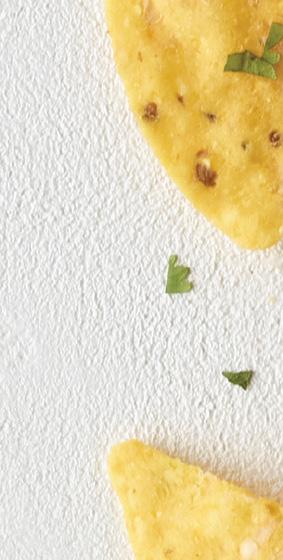



TRY IT YOURSELF. REQUEST A SAMPLE.













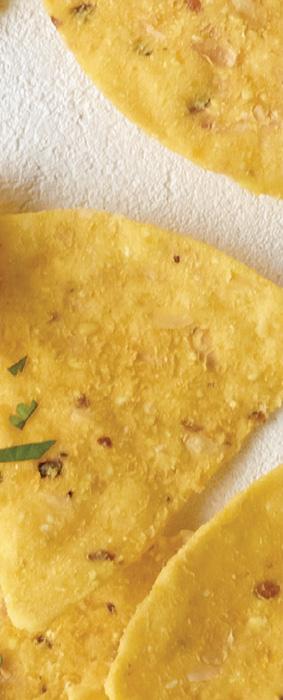

SCAN THE CODE TO GET STARTED.









MEGAMEXFOODSERVICE.COM/BRAND/WHOLLY-AVOCADO/ • 1-817-509-0626



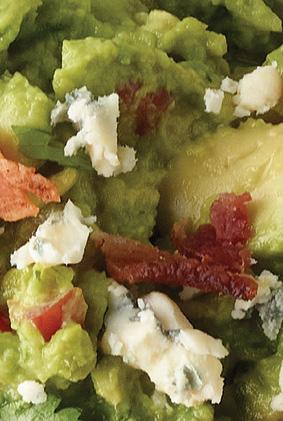


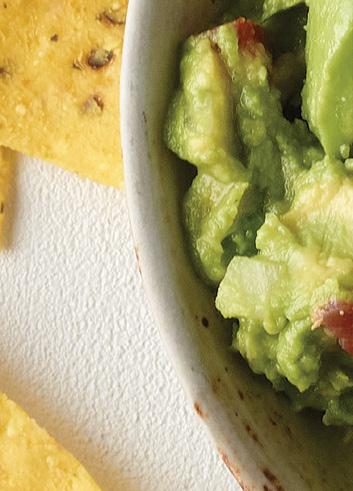

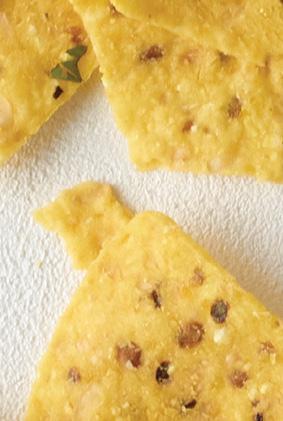









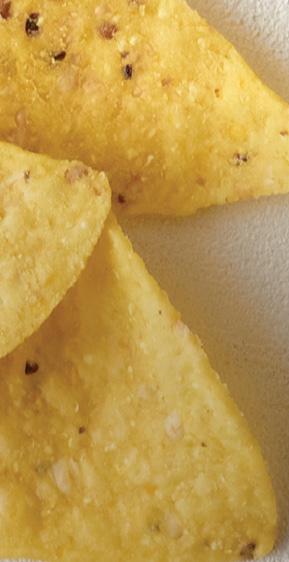

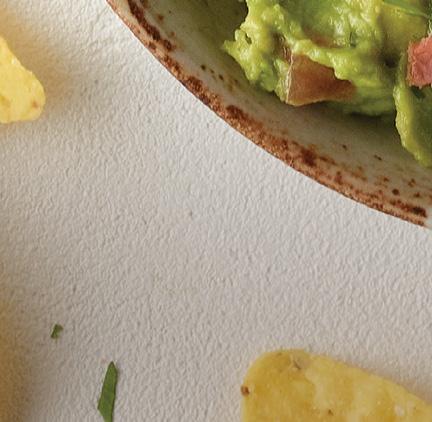







©2023 MegaMex Foods, LLC
Five James Beard Award Winners with MEXICAN/LATIN CONNEC TIONS

MEXICAN/LATIN RESTAU
RANTS, CHEFS and related individuals made a solid showing at the 2023 James Beard Awards, with five overall on the podium.

Topping the list was Chef Natalia Vallejo of Cocina al Fondo in San Juan, Puerto Rico, who won Best Chef: South. In an interview with el Restaurante writer Natalia Otero, Chef Vallejo explained that she comes from a long line of women who have molded Puerto Rico’s cuisine.

“The cooks in Puerto Rico are women who have known how to stand in front of the fire,” Vallejo said. “These women are the ones who have made a family and have moved a gastronomic economy without knowing it. I defend that tradition.” (Read the exclusive interview at elrestaurante.com, and turn to page 27 to learn about her Flan de vanilla ‘Carmencita’ dessert, pictured on the cover of this issue.)
Another winner was Yoli Tortilleria in Kansas City, Missouri, which took home the Outstanding Bakery award. Yoli Tortilleria’s award is the first ever for that category. The company was founded by Mark and Marissa Gencarelli. According to the website, Yoli Tortilleria “is inspired by Marissa’s upbringing in Sonora, México. Yoli products reflect the rich diversity in Mexican cuisine. They follow traditional processes native to México, but use local
and seasonal ingredients found in the Midwest.”
The other three Mexican/Latin winners were in the media categories.
“Masienda Presents,” a video series about masa and the people who use it, which was produced by Masienda, the heirloom corn company, won the James Beard Media Award in the Commercial category.

Illyanna Maisonet, a writer and food columnist, won the Emerging Voice award for her “deeply personal” cookbook about Puerto Rican cuisine, “Diasporican: A Puerto Rican Cookbook.”

And “Mi Cocina: Recipes and Rapture from My Kitchen in Mexico: A Cookbook,” by Rick Martínez, won the book award in the International category. The book is described as “A highly personal love letter to the beauty and bounty of México in more than 100 transportive recipes.”
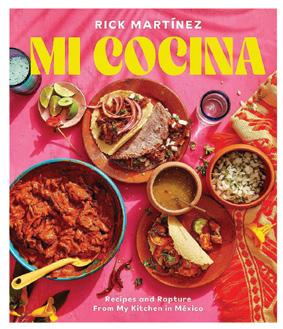
hotline
6 el restaurante | JULY/AUGUST 2023

Cookbook Author: AREPAS ARE THE NEW TACO

WHEN IRENA STEIN noticed that millions of people were leaving her native Venezuala, she realized that the signature sandwich of that country — the arepa — would rapidly spread around the world. Stein, who came to the United States in 1980 and owns Alma Cocina Latina in Baltimore, decided to honor that dish by writing a cookbook, Arepa, which became available in July.

She believes that not only will the flood of Venezuelan emigrants foster the love of arepas, but for many, producing this dish will be a first step for generating income in their new homes.
“Thousands of excellent Venezuelan chefs have begun
spreading this food around the world, and I honestly believe that arepas are the new taco, which for some time now has been globally adopted,” she says. “That is why the book is written in English. P.A.N. flour (a popular brand of precooked corn meal used for arepas) now is sold in 90 countries, it’s crazy.”
Stein collaborated with Chef Eduardo Egui on the book, which is distributed by Simon & Schuster.


“The book has 50 recipes, from easy to more elaborate,” she explains. “It includes our philosophy and is dedicated to those refugee migrants all over the world who settle in new cultures. The arepas are a cultural symbol of ours and recently they are also becoming part of haute cuisine….They are democratic, simple. It doesn’t matter if you’re in a suit or whoever you are, and that’s what I want; the reader of my book is someone who wants to enjoy the flavors and nothing else.”
See recipe for Arepa de Coco on page 63.
hotline 8 el restaurante | JULY/AUGUST 2023 Introducing…Our NEW, Industry Elite 800-777-4498 715-394-2422 sales@dutchessbakers.com dutchessbakers.com All the equipment you need to make hot, fresh tortillas in-house in one convenient package! • Manual Dough Divider (36-part head included) • Dough Rounder • Portable Stand (with casters) • Manual Tortilla Press (15-inch square platen, swing-away design) • Tortilla Press Cart

WHAT’S IN YOUR WALLET? We Know What Masienda’s Founder Carries
ALL OF THE TV ADS FOR CAPITAL ONE’S BUSINESS CREDIT CARD are approximately the same: Some business owner used the cash-back feature to buy something else for the business, and so on. But one Capital One ad that started running during the NBA playoffs in April hit home for the Mexican restaurant industry. It featured Jorge Gaviria, founder of Masienda, a company that supplies heirloom Mexican-grown corn for making masa.
“Someone from Capital One reached out to me in 2019 or 2020 and wanted to know if we had any good experiences with the card that were different,” Gaviria says. “We had redeemed about $40,000 of rewards to finance our new Molinito corn mill, which grew into a million-dollar business. They loved that angle and felt it was something that would relate to the entrepreneurial community.”
In 2021, filmmakers spent three days with Gaviria shooting the commercial. They collaborated on the script so that Gaviria could promote the Molinito, which is a tabletop molino for grinding nixtamalized corn into masa, while highlighting the benefits of using the Capital One Spark Cash Plus Card.
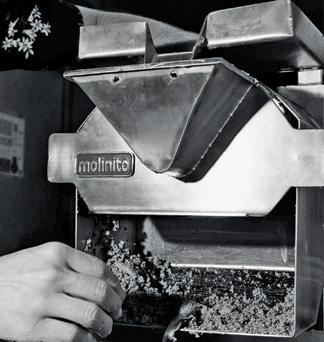

“It was fun,” Gaviria remembers about the filming. “I got to work with a large professional commercial team. I live in LA and I’m very interested in the entertainment industry, so to be part of that was a cool experience.”
About two years later the ad hit the airwaves and Gaviria immediately noticed a jump in business.
“The Molinito is meant for a very specific group. There’s a bit of a ceiling in so far as how many people are grinding corn into masa on a daily basis, but the ad has driven traffic to our site and increased sales for the other products,” he says. “Our masa sales are through the roof right now; they’re at or higher than holiday 2022 levels.”

Want to watch the ad? Search on Youtube for “Masienda Capital One Commercial.”
“WE
hotline
10 el restaurante | JULY/AUGUST 2023
HAD REDEEMED ABOUT $40,000 OF REWARDS TO FINANCE OUR NEW MOLINITO CORN MILL , WHICH GREW INTO A MILLION DOLLAR BUSINESS. THEY LOVED THAT ANGLE AND FELT IT WAS SOME THING THAT WOULD RELATE TO THE ENTREPRENEURIAL COMMUNITY.”
JORGE GAVIRIA

Tacombi Expands Charitable Efforts
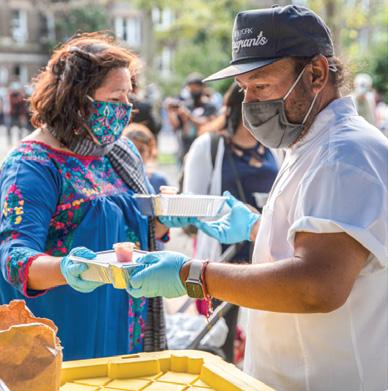

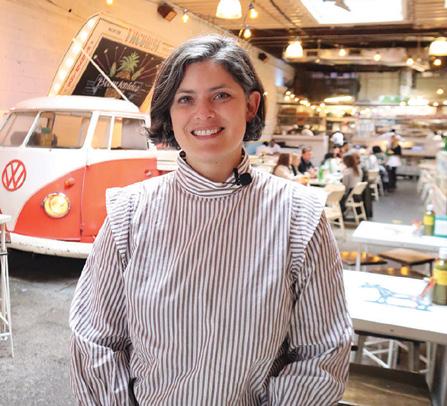

TAQUERIA CHAIN TACOMBI IS GROWING more than the number of locations it operates throughout the US; the company also is growing its efforts to help people in the communities surrounding its restaurants (currently numbering 16) by launching a work training program. The effort, which will be run by the Tacombi Foundation, should launch this fall, says Susana Camarena, the company’s senior director of impact and culture.
“We are building a program that will allow people to get trained in the restaurant industry and back of house and front of house, and also to gain human skills that can help them to continue growing and going up within this industry,” Camarena says. “The idea is that once they go through the program, they can find jobs that are suited for their next step in their career.”
The training will occur in the taquerias before the doors open at 11 a.m., and the trainers will be a mix of outside experts and Tacombi’s staff.
Camarena explains that the program is more than just an employee-training program: “Obviously, we are going to have opportunities here at Tacombi for some of them, but we don’t want to narrow down their opportunity to Tacombi. They can go wherever they want. This is not for Tacombi. This is for them.” The new job training program is not Tacombi’s first effort to help its neighbors. An existing project of the Tacombi Foundation is the Community Kitchen, which uses Tacombi’s kitchens to prepare meals for people in need. To date that program has created over 600,000 meals.
“This [Community Kitchen] enhances the reputation of the brand because it’s aligned with our core values and we feel proud about not only existing to serve our guests, but also our team members and our community,” Camarena says.
“And this has provided a lot of pride and meaning to our team members because they know that they’re part of something bigger.”
hotline
12 el restaurante | JULY/AUGUST 2023
“THE IDEA IS THAT ONCE THEY GO THROUGH THE PROGRAM, THEY CAN FIND JOBS THAT ARE SUITED FOR THEIR NEXT STEP IN THEIR CAREER.” SUSANA CAMARENA
The Mission: Connecting Customers to Mexico
TACOMBI WAS BORN IN A 1963 “COMBI BUS” — purchased in Mexico City — “on the balmy beaches of the Yucatán in 2006 with little more than a cloudless, palm-filled dream of sharing the beauty of authentic Mexican culture with the world.

“The engine was scrapped, transmission sold, seats swapped for cooking equipment, and the roof was reeled back to produce a taco-serving stand with warmth, charm and character,” a history of the company explains. Those tacos were served from the bus-turned-food truck parked “comfortably in the once-sleepy, now wide awake, beach town of Playa del Carmen.”
The first Tacombi taqueria debuted in a downtown New
2023 Contests Still Open — Enter Now!
There’s still time to enter el Restaurante’s Sassiest Salsa Contest, sponsored by Sammic, and to nominate your manager for the our Manager of the Year Award, sponsored by Jarritos. Winners will receive cash prizes and framed certificates, and will be featured in the November/December 2023 issue of el Restaurante.

The deadline to enter a recipe in the Sassiest Salsa is August 18; visit elrestaurante. com/2023-salsa-contest/.



The deadline for Manager of the Year awards nominations is September 8; visit elrestaurante. com/2023-manager-contest.

York garage in 2010; locations in New York, Washington D.C. and Miami followed.
“Within our taqueria walls we also started producing our own authentic, traditional ‘Vista Hermosa’ tortilla products to preserve and share the flavors of Mexico and offer these products through stores across the country,” the company history says, adding that sharing authentic taco culture is the goal. “Our taqueros proudly work every day to preserve and share Mexico’s culinary traditions.”
JULY/AUGUST 2023 | el restaurante 13
World’s Best Female Chef Weighs in on Women in the Restaurant Industry

It’s big news in the Mexican restaurant industry when one of our own garners big culinary honors. And there’s perhaps no bigger accolade than being named World’s Best Female Chef in The World’s 50 Best Restaurants awards — which is just what happened to Elena Reygadas (or as she prefers to call herself, Cook), chef-owner of Rosetta in Mexico City, in June. Here, in an edited excerpt from her interview with el Restaurante freelance writer Natalia Otero, Reygadas shares her thoughts about the challenges female chefs face in the restaurant industry.
el Restaurante: How can we close the gap between women and men in the industry?
Elena Reygadas: Actions must be, first of all, structural. Inequality between men and women in the restaurant industry cannot be ended if it is not ended in society as a whole. However, I believe that we can promote concrete actions that help to close it. In personal terms, I started a scholarship to support Mexican women studying gastronomy. What we sought was to strengthen the leadership of women and [ensure] that there are equal opportunities. Many families still send only the men to study. We have to stop with those ideas.
el Restaurante: How have you experienced this imbalance?
Reygadas: In various ways and, sadly, on an ongoing basis. However, I think things are beginning to change. There is greater awareness. The global feminist struggle that we have seen unfold over the last few years has been fundamental to this.
el Restaurante: How does the imbalance between men and women in kitchens affect women’s careers?
Reygadas: Something happens in the kitchen that could almost be called paradoxical. In our patriarchal societies, in historical terms the kitchen has been conceived as a feminine space. There are still people who say as an insult to women: “Go to the kitchen.” However, the restaurant industry is dominated by men. They have thrown us into the kitchen space and, at the same time, they have made us invisible. I believe that women can reclaim the kitchen space as a space for sharing, resistance and creativity.
el Restaurante: Has this imbalance affected you?
Reygadas: Yes, although I have been enormously privileged. It seems fundamental to me to continue fighting day by day until we are able to establish an egalitarian and just society for everyone.
el Restaurante: When and for what reason did you launch the Elena Reygadas Scholarship?
Reygadas: I launched it in 2022. The reason was the inequality that I saw between men and women in the industry. After much thought, I wanted to contribute something. The idea of the scholarship is to support young Mexican women who study gastronomy, with the aim of promoting equal opportunities and strengthening female leadership. In 2022, we gave scholarships to three young Mexican women. This year, in alliance with the Santander Bank Foundation, we will grant scholarships to 40.
THE CULINARY INSTITUTE OF AMERICA ANNOUNCES LINEUP FOR LATIN AMERICAN CUISINE SUMMIT
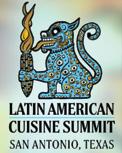
The Culinary Institute of America’s (CIA’s) 2023 Latin American Cuisine Summit — set for September 12-13 at the CIA’s campus in San Antonio’s Pearl District — will bring together foodservice, culinary, and beverage professionals for culinary demonstrations, academic presentations, tastings, robust discussions, and peer-to-peer exchanges. Topics will include the intersection between cuisine and culture, the importance of local sourcing, and techniques from traditional foodways such as preservation, preparation and food production.
Ed Avis, publisher of el Restaurante, is honored to among the featured speakers on a list that includes these Latin foodservice leaders:
Gabriella Ruiz, chef-owner of Carmela & Sal in Mexico City and of Vuelve Carmela in Tabasco
Fermin Núñez, executive chef of Suerte in Austin
Melissa Guerra, culinary expert and food historian specializing in foodways, especially Texas regional, Mexican, and Latin American cuisine
Elizabeth Johnson, chef at Pharm Table in San Antonio
Adán Medrano, chef, food writer and author of Truly Texas Mexican: A Native Culinary Heritage In Recipes” and Don’t Count the Tortillas – The Art of Texas Mexican Cooking Diego Galicia, executive chef/co-owner of Mixtli in San Antonio
Jesús Escalera, chef/owner at La Postrería in Guadalajara
Rupa Bhattacharya, executive director for the strategic initiatives group at The CIA April Goess, director of education at The CIA San Antonio
Daniel Lessem, corporate chef and director of educational partnerships at RATIONAL USA
FOR MORE INFORMATION AND TO REGISTER, VISIT ciaprochef.com/latin-american-cuisine-summit/
14 el restaurante | JULY/AUGUST 2023
hotline
The California Foodservice Instant Rebates Program is funded by California utility customers and administered by Southern California Gas Company (SoCalGas ®) and supported by the state’s other investor-owned utilities (IOUs), Pacific Gas and Electric Company (PG&E ®), Southern California Edison Company (SCE ®) and San Diego Gas & Electric Company (SDG&E ®), under the auspices of the California Public Utilities commission through a contract awarded to Energy Solutions. Program funds, including any funds utilized for rebates or incentives, will be allocated on a first-come, first-served basis until such funds are no longer available. This program may be modified or terminated without prior notice. Customers who choose to participate in this program are not obligated to purchase any additional goods or services offered by Energy Solutions or any other third party. The selection, purchase, and ownership of goods and/or services are the sole responsibility of customer. None of the above-mentioned IOUs make any warranty, whether express or implied, including the warranty of merchantability or fitness for a particular purpose, of goods or services selected by customer. None of the IOUs endorse, qualify, or guarantee the work of Energy Solutions or any other third party. Eligibility requirements apply; see the program conditions for details.










© 2023 Energy Solutions. The
Some
used under license, with all rights reserved by licensor. Contact Energy Solutions: (714) 787-1098 instantrebates@energy-solution.com Savings on the spot! Save up to $3,000* per unit on high-efficiency equipment Save up to $900 per vat Save up to $3,000 per cavity Fryers Combination Ovens Save up to $600 per cavity Convection Ovens Save up to $100 per unit Refrigerators & Freezers *Scan or go to caenergywise.com/instant-rebates for more information and a full list of eligible products. Rebate amounts as of January 1, 2023
trademarks used herein are the property of their respective owners. All rights reserved.
materials
CHEF JUAN J. SANJUAN III
Gloria’s R taurant & Bar
EDITOR’S NOTE : When el Restaurante Publisher Ed Avis met Chef Juan J. Sanjuan III at the 2023 Antojo Industry Trade Expo in Los Angeles last May, he was intrigued by the chef’s presentation about the cultural importance of providing authentic Mexican food. In this excerpt from a post-show interview, Sanjuan — owner of Gloria’s Restaurant & Bar in Huntington Beach, California, and CEO of the non-profit Chefs Supporting Chefs — shares the details of his culinary journey and his current e
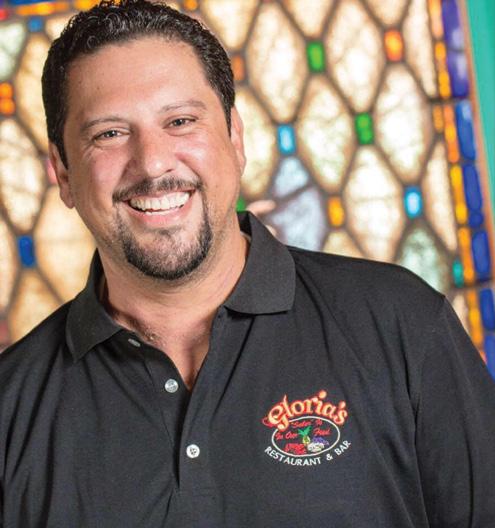
1 HOW DID YOU GET INTO COOKING AND DECIDE TO BECOME A CHEF?
We didn’t have a lot of money. My dad had broken his back in a factory accident...little by little he started recovering. He started selling paletas for a little shop that was near our house. Then he started selling seafood. He met the owner of a restaurant, and [eventually] made the deal to lease the space and we opened Gloria’s. We opened it in 1982, and I was 10 years old. When you’re part of the fam-
orts to unite people around food.

ily, you work. So, every weekend at 5 o’clock in the morning, I had to get up. Part of that was because we had been on food stamps. We really didn’t have anything. We were at the point of losing our house. So, it’s like, “Everybody, hands to the grill and let’s get to work.”
2 WHAT DOES AUTHENTIC MEAN TO YOU?
Authentic, to me, doesn’t necessarily mean that it has to be traditional dishes, where you can’t be fusion. Authentic, to me, just means authentic to yourself. I cannot fake who I am. I am not a character.
When I was a little kid, my dad, one time, went to pick me up. I was in 5th or 6th grade, and my friends all said, “Bye, John. I’ll see you later.” My dad says, “Who’s John?” I said, “Oh, that’s me.” He says, “No. You’re Juan Sanjuan. You’re not John.” The next day, I come into school and everybody’s, “Hi, John.” I’m like, “Hey, whoa, whoa, whoa, whoa. I’m Juan Sanjuan, guys.”
Now, I’m Juan Jose Sanjuan, III. I focus on traditional cooking. I love my stories of Mexico. I love mariachi. I love our culture. Whoever you are, just be you. Don’t try to fake it. If you love fusion, knock it out. If that’s what’s true to you, if that’s what’s authentic to you, then do it. You know what? If you fake it, people will find out. Whatever you are, whatever you want to do, that passion that you have, be true to it. What’s the definition of authentic? What kind of carne asada is authentic? Does it have to have this? No. Just be authentic to you and whatever you want to do, man…. that’s what authenticity means to me.”
16 el restaurante | JULY/AUGUST 2023 five questions
ff
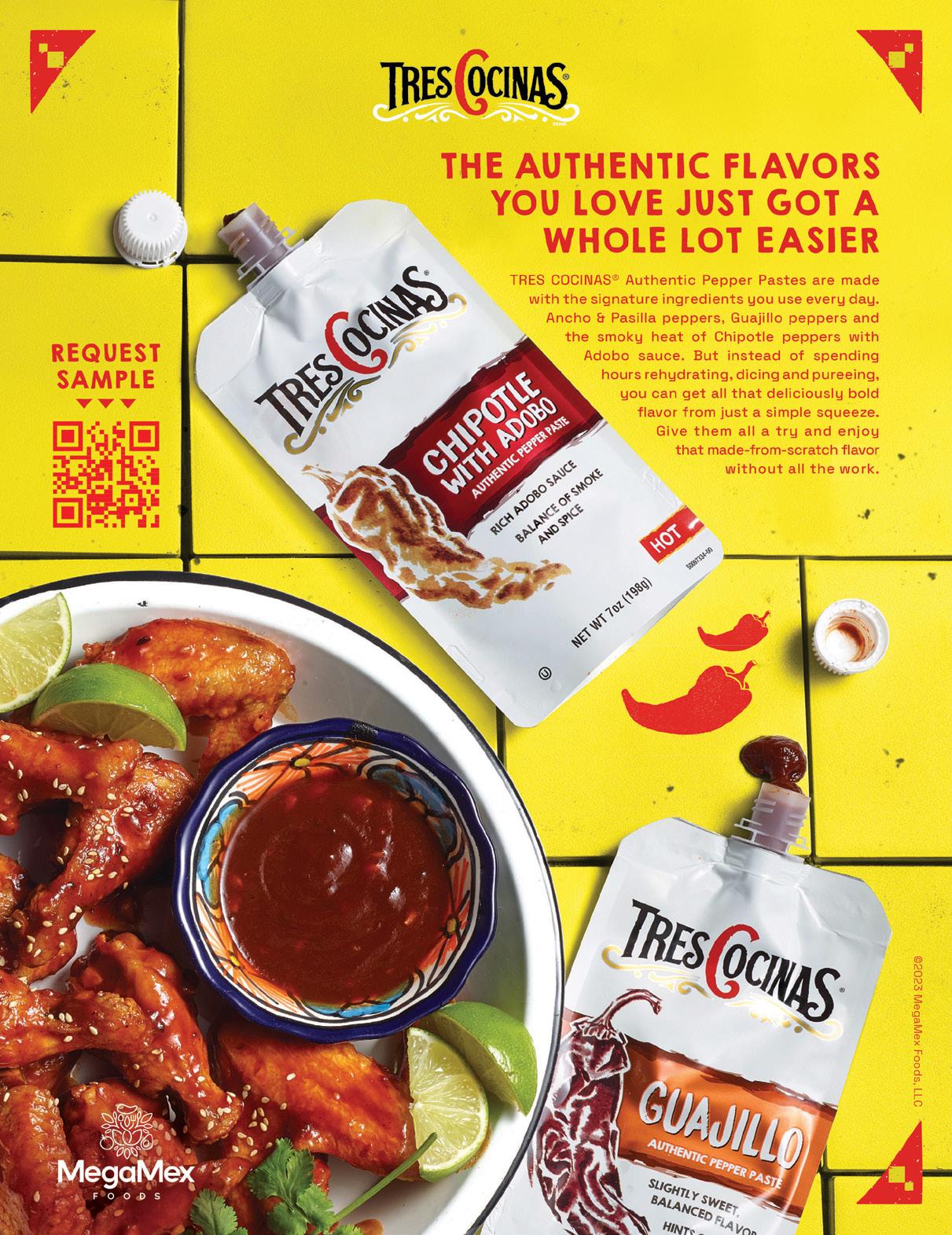
HOW IMPORTANT IS IT FOR THE LATINO COMMUNITY TO HELP AND SUPPORT ITSELF?
I always feel that, as Latinos, we don’t really raise our voices too much. We are more of a quiet people, and we gravitate towards our food, our family, who we are. We’ve been programmed to think that we can’t get along with each other. So, I’ve always thought like, “Hey, if we’re not much for protesting…[what can we do?].”
Team up with the right Mexican, team up with the right Latino. If we come together as a community and we uplift each other, we will realize our potential. [It’s not only about] politics [but also about] economic potential, what we bring to this community, what we bring to food and the culture. If we could just learn to unite, the power [that we could have]! I love sitting down and talking to other chefs and learning from them. Why don’t we come together? Why does it have to be the Mexicans against the Salvadorians against the Nicaraguans? If we really think about it, we were just one big piece of land with a bunch of tribes that have so much to offer to each other.
There are so many beautiful things that can come out of our cultures if we just learn to unite. But, I feel that it’s always a division, “Oh, well, I’m Mexican. Well, I’m Salvadorian. Well, I’m this.” Well, do we have to break each other apart? Can’t we unite? That, to me, is what’s important.
4ANY IDEAS ON HOW TO UNITE?
I’m not about politics. I’m about uniting through food. Part of my project that I’m doing now is a little restaurant in downtown LA on Olympic, across the street from the Regal Theater. There was a little cul-de-sac there and we got the permits to get the cul-de-sac, as well.
I told my business partner and the co-founder of Chefs Supporting Chefs, Michael Juarez, “We’re not using this cul-de-sac for us.” We’re going to build a little night market. We’re calling it CSC Mercado, Chefs Supporting Chefs Mercado, where we bring in food vendors. I’m helping to get them health department certified. We’re getting them SBA loans. We’re getting them little micro loans. We have a graphics department that’ll help them with signs. T-Mobile has
donated 100 hundred tablets so they can have social media. I was like, “Michael, this cul-de-sac is not ours. This is for our community.” I want to show people that if we unite, man, what we can bring to downtown.
My goal is to create a little Pueblo Magico, like in Mexico. Our hometown Mascota in Jalisco is a Pueblo Magico. We built this little mini pueblo island in the middle of downtown, and people can see that we’re united through food. It’s a big, beautiful, cultural experience — like a cultural event that we have every weekend. You start bringing in people. You start showing that through food, we can unite. Food is the way we’re going to come together. Food’s not just nourishment for your body, it’s nourishment for your soul.

5TELL ME MORE ABOUT CHEFS SUPPORTING CHEFS.
The rst week of the pandemic [we thought] we’re going to close down for two weeks. I had a restaurant full of food. I told my manager, Liz Belloso, “Mija, I don’t want to throw shit away. We’re going to do a food drive.” I was like, “What can I feed [people] so we can use all of this without having to work so hard as far as production?” I thought, “Burritos. If we give people one burrito a day, we can at least ll them up.”
I called Aaron Sanchez, Master Chef. I said, “Aaron, I need you to help me publicize it, bro. I don’t have a large social media…I don’t have the reach that you do.”
He ew down from Louisiana. He sent me one of his recipes, and we started doing just burritos. We put it up on social media. I’m not kidding you, we had about 15 news outlets [interested in covering it]. All of a sudden it started spreading. We were set to start at 9 am, [and only] two cars showed up. I put my head in my hands, and I was like, “Lord, whats up? You told me, ‘If they build it, they will come.’ I’m trying to do good here. I’m really trying to help out.” Within ve, 10 minutes, Liz knocks on my window in the of ce [and says], “Come here, come here.” There was probably about a mile long line of cars. From that moment on, it was burrito production on steroids, bro. It became addicting from there. We ended up getting some sponsors, and we started doing it at different restaurants. Then a buddy of mine, Manny Hinojosa, the Global Ambassador for Cazadores, calls me and he says, “Hey, my friend in Visalia, he needs help. He sees what we’re doing, and [wants to know] if we can help feed farm workers.” So, there we go to Visalia, two and a half hours away….
After several twists and turns during the pandemic, Chefs Supporting Chefs blossomed and ultimately became a national non-profit. For more information about the organization, visit chefssupportingchefs.org
3
five questions













VILLASEÑORFAMILY T R ADITIONTM –EST.1964 AUTHENTIC MEXIC AN PRE-COOKED FROZEN CHORIZO, Delicious and Versatile, ready in minutes! V&V®, V&V SUPREMO® & DESIGN ARE REGISTERED TRADEMARKS OF ©V&V SUPREMO FOODS, INC., 2023 Serving Suggestion: Meat Lover’s Pizza Serving Suggestion: Classic Chorizo and Eggs SCAN TO REQUEST A FREE SAMPLE
desserts that
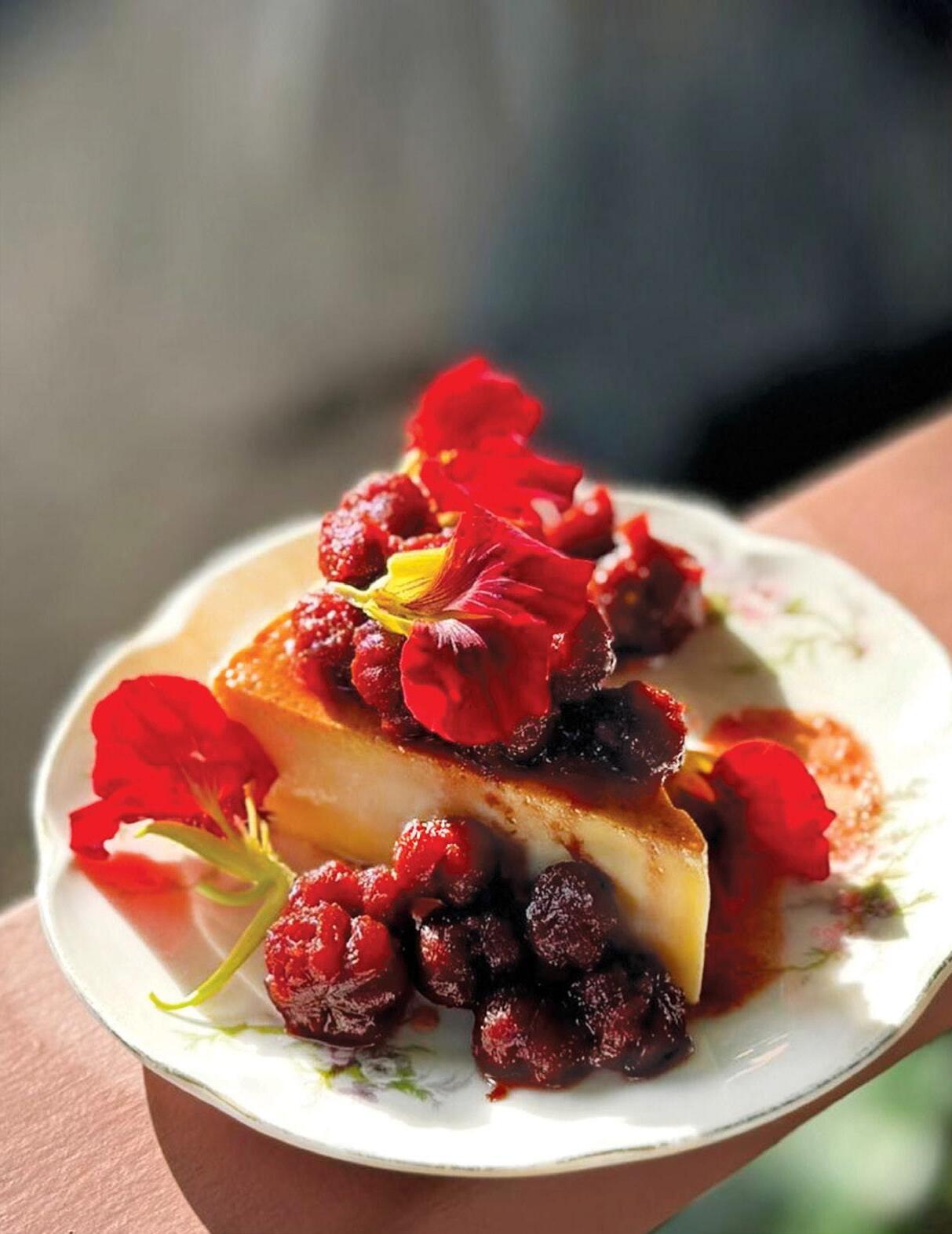
TAPPING TRENDS TO ENHANCE END OF MEAL MENUS
DELIGHT
Flan de Vainilla ‘Carmencita’ from Cocina Al Fondo
| BY ANNELISE KELLY | Judging by many Mexican restaurant menus, desserts are an afterthought, with many relying solely on standbys like basic an or tres leches to ll diners’ cravings for a sweet end-ofmeal treat.
But dessert can transform a delicious meal into a celebration — the culinary version of topping a package with the perfect bow. From the restaurant operator’s perspective, it offers an ideal opportunity to keep customers in-house a bit longer, sweetening their experience, their bill and your bottom line.
LET’S TALK TRENDS
What are customers looking for when they want to splurge at the end of a meal?
According to data from the 2023 Desserts Keynote report from food and beverage market research rm Datassential, globally inspired desserts — an especially apt category for Mexican and Latin restaurants — are among the trends consumers and operators are embracing:

About the Cover Photo
41 percent of consumers are interested in globally inspired desserts.
28 percent of operators currently offer globally inspired desserts.
38 percent of operators are interested in adding globally inspired desserts to their offerings.
The Flan de Vainilla ‘Carmencita’ is “one of the jewels” at Cocina Al Fondo in San Juan, Puerto Rico, where the menu from Chef Natalia Vallejo — winner of the 2023 James Beard Award for Best Chef: South — brings the countryside to the city, tradition to modern life. Vallejo named the dish in honor of her mother, who proposed adding it to the dessert menu. It isn’t always offered, but when it appears, it sells very quickly.
“That dessert is one of the few recipes that my mother has, and it is the typical one that she brought to family parties,” Vallejo says. “It has been a success because it represents our ancestors. It comes from that line, from that tradition, combined with a currant jam that gives it a touch of freshness. It is a classic, rustic dessert that represents family union, partying, sharing, and grandmother.”
“We are witnessing a trend towards more healthconscious options without compromising on flavor. Customers are increasingly seeking desserts made with organic, natural ingredients and those that cater to dietary restrictions such as gluten-free or vegan options.”
JULY/AUGUST 2023 | el restaurante 21 | COVER STORY |
Alejandra’s Gluten-free Tres Leches Cake
EXECUTIVE CHEF NOEMI GUZMAN, Jalao NYC
Frozen desserts from global cuisines, in particular, are those that Datassential calls one of the 10 dessert “mega trends,” with 39 percent of consumers nding them extremely or very appealing.
Health and dietary considerations represent another signi cant trend in the category.
According to Datassential, four out of ve consumers are at least somewhat interested in mini desserts.
“Considering these results, it makes sense for restaurants and foodservice establishments to offer more small desserts, particularly considering that more consumers are tting a treat into their day instead of having a big dessert after dinner,” Datassential information says. “Since price doesn’t factor as high with desserts as it does with other food, mini desserts can be a great option for foodservice operators looking to grow sales.”
Datassential also reports that 26 percent of consumers overall, 39 percent of Gen Zers, and 35 percent of millenials reported an interest in diet-speci c desserts, and cites vegan desserts as a category operators should not ignore. “These desserts are still a draw for over a quarter of the population, and 45 percent of millennial consumers,” information from Datassential says. “Having vegan varieties available was important to more than a third of consumers buying desserts at a restaurant or to take home.”
RESTAURANT RENDITIONS OF TRENDING SWEETS

Many restaurants are transforming their dessert menus by putting global twists on familiar desserts, upscaling basic Mexican and Latin confections, and incorporating options for health-conscious diners.
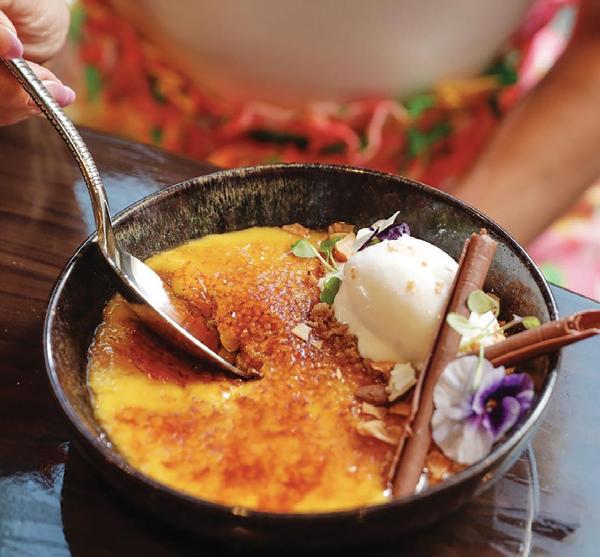
At Jalao NYC, a Dominican restaurant in New York City, executive chef Noemi Guzman nds inspiration in a multitude of sources. “Traditional Latin desserts hold a special place in my heart, as they represent the rich culinary heritage of my Dominican roots,” says Guzman, who enjoys infusing Latin ingredients such as plantains, coconuts, and tropical fruits into her creations.
The Jalao Cheesecake that incorporates coconut, dulce de leche, chocolate mousse and coconut crème anglaise is one example. She also offers Classico Majarete, a traditional corn pudding elevated with ice
22 el restaurante | JULY/AUGUST 2023 | COVER STORY |
“From a profit perspective, desserts play a crucial role in our overall financial performance at Jalao. They contribute significantly to our revenue stream and help enhance our profitability.”
EXECUTIVE CHEF NOEMI GUZMAN, Jalao NYC
Tabu’s Churroulette
Jalao’s Classico Majarate





©2023 Performance Foodservice Exclusively distributed by AUTHENTIC LATIN FLAVORS Our portfolio of Latin foods sourced for authentic taste and flavor. Contigo ® offers many diverse flavors that vary from Mexico and the Caribbean to Central and South America. 3 Layer Pineapple Brown Sugar Cake PFS# 807646 Scan the QR code to contact us or go to WWW.PERFORMANCEFOODSERVICE.COM/CONTIGO for more information on Contigo products! NEW! Guava Cheesecake (gluten free) PFS# 174790 3 Layer Coconut Cream Cake PFS# 807645
cream and crumble, and the Five Leches Dominicana, an updated take on tres leches that’s made with soaked sponge cake, strawberry coulis, mixed berries and Chantilly cream.
The “ ve” refers to ve layers: whole cow’s milk; a layer of caramel-like dulce de leche (“which is a very traditional dessert from the Dominican Republic,” Guzman says); condensed milk; evaporated milk; and goat ricotta.


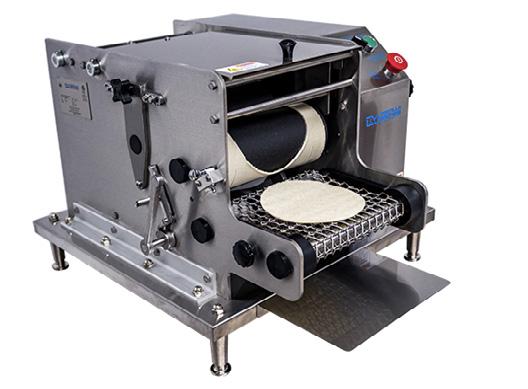






A tropical version of tres leches stars at Pambiche, a Cuban restaurant in Portland, Oregon. There, co-owners and chefs John Maribona and Rosanne Romaine (once known as the Batman and Robin of pastry at some Portland restaurants!), have dubbed the dessert The Lime in the Coconut — lime sponge cake drenched with saoco sweet coconut milk, fresh lime and Bacardi Superior Rum, filled with coconut custard cream, and dressed with Chantilly cream. (continued on page 26)

| COVER STORY | 24 el restaurante | JULY/AUGUST 2023
Pambiche’s The Lime In The Coconut
Promoting and Upselling Desserts



You’ve got a focused selection of desserts that you’ve designed to be profitable and appealing. How do you make sure guests buy them?
Engage Staff. Your waitstaff is key to selling more desserts. “First and foremost, we train our staff to be knowledgeable about the dessert offerings and encourage them to recommend specific options to guests,” says Noemi Guzman, executive chef at New York City’s Jalao NYC. “Additionally, we highlight our desserts on the menu twice, with the savory selection and separately at the end with an independent menu.”
“We promote dessert in the restaurant on a daily basis through our servers,” says David Wierman, president at Cantina Laredo. “The upsell part relies on the servers to make sure they are offering the desserts to every guest who walks through our doors.”

Make Presentation a Priority. When it comes to desserts, the importance of presentation can’t be overstated. As Wierman says, “You eat with your eyes… At Cantina Laredo, we use a dessert tray our servers can take to the table towards the end of the meal. The servers show and describe our dessert offerings.”
Pambiche in Portland, Oregon showcases desserts in a classic well-lit pastry case, visible from the front door. Chefs/owners Rosanne Romaine and John Maribona set the front counter up that way, “then realized it really was a draw,” says Romaine. “It literally would bring people in who were not looking for dessert — but it caught their eye as they were walking by.” Now some customers come in solely for the desserts, she says.
The Optimal Automatics Autodoner is ideal for preparing cones of al pastor and other stacked meats. Comes in many sizes and models, including natural gas, electric, and LP. Se habla espanol 847-439-9110 www.optimalautomatics.com Se habla espanol 847-439-9110 www.optimalautomatics.com
Juan’s Margarita Floats
DATASSENTIAL


Another Pambiche standout is the Guava Cheesecake — a rich round of cheesecake set atop a vanilla cookie crust and bathed in a sweet guava glaze. At 16 restaurants in the Dallasheadquartered Cantina Laredo chain, Mexican Apple Pie is the most popular dessert, according to company president
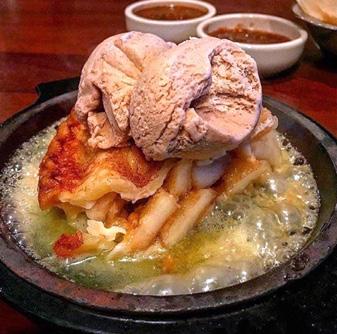
David Wierman, who describes how the kitchen puts a very Hispanic spin on a very American favorite. “We bake the pies in-house and serve them on a sizzling skillet, elevated with brandy butter made with Mexican brandy and a canela (cinnamon) ice cream full of avor like you’d expect to get in Mexico.”
In addition to the Mexican Apple Pie, customers can choose from an with a hint of Cointreau; Mango Tres Leches Cake; and a warm brownie on a sizzling skillet with Mexican brandy butter, walnuts and whipped cream.
Chef de Cuisine Abner Peralta at Alejandra’s Fine Mexican Food and Cantina in Carlsbad, California is also inspired by tradition. “We always want to make everything taste and look as authentic as possible, but I’m always
up for the challenge to fuse everything with something modern or different, and I love to play around with seasonal avors,” Peralta says. His menu includes innovative spins on tradition in the Horchata Cheesecake and the Tangerine Flan with brûléed tangerine, crumbled crepes, and tangerine supremes.
On the globally inspired frozen dessert front, Juan’s — a Mexican restaurant with locations in Gloucester, Newport News, and Richmond, Virginia — recently introduced the Margarita Float. It’s the latest addition to the restaurant’s menu of soft serve margaritas, which dessert-craving diners also can nd at Barrio Taqueria & Cantina in Richmond.
And on the less-can-be-more side is the Churroulette from Tabu in Chicago,
41 percent of consumers are interested in globally inspired desserts.
26 el restaurante | JULY/AUGUST 2023
Cantina Laredo’s Mexican Apple Pie
which features mini churros set in shot glasses lled with dulce de leche, dark chocolate and guava.
Similarly, Guzman and Peralta are working to make sure diners following special diets have delicious choices for sweet endings.
“We are witnessing a trend towards more health-conscious options without compromising on avor. Customers are increasingly seeking desserts made with organic, natural ingredients and those that cater to dietary restrictions such as gluten-free or vegan options,” Guzman says. “It’s important for us as chefs to adapt to these preferences and offer a diverse range of desserts that cater to various dietary needs. For most of our ingredients in our desserts we try to use
corn.orders@clarksongrain.com

organic or fresh ingredients from local farms. For example, for our Majarete we use organic corn.”
Alejandra’s Peralta agrees. “Since I joined Alejandra’s, the most popular and best-selling dessert is our Gluten-Free Tres Leches Cake,” Peralta reports. “We recently added our Gluten-Free Churro Bites Dessert and it’s becoming as popular as the cake. People love them, especially when our servers let them know that they are gluten-free.”
THE BOTTOM LINE
No matter the menu, desserts can play an important role in a restaurant’s nancial success. In fact, 60 percent of operators say that the desserts they offer help drive pro t, Datassential reports.
That is true at Jalao, according to Guzman, who estimates that about 50 percent of customers order dessert.
“From a pro t perspective, desserts play a crucial role in our overall nancial performance at Jalao,” Guzman says. “They contribute signi cantly to our revenue stream and help enhance our pro tability. We carefully analyze the cost of ingredients, portion sizes, and pricing to ensure that our desserts are not only delicious but also pro table. By offering enticing and delectable dessert options, we can increase our average check size and enhance the overall dining experience, ultimately contributing to our nancial success.”
JULY/AUGUST 2023 | el restaurante 27
Annelise Kelly is a Portland, Oregon-based writer and frequent contributor to el Restaurante.




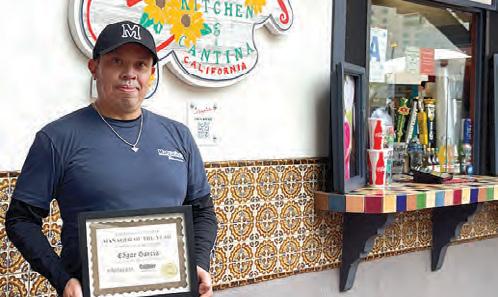


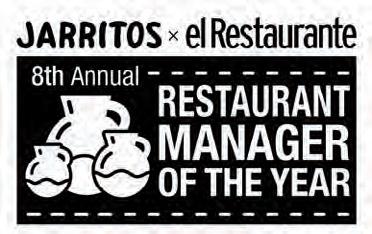
HONOR
MANAGERS!
FOR MORE DETAILS AND TO ENTER: VISIT www.elrestaurante.com/2023-manager-contest Sponsored by Jarritos
MANAGER OF THE YEAR AWARD
YOUR
Every manager nominated will receive a certificate honoring the nomination and will be named in the Nov/Dec 2023 issue of el Restaurante . Award winners will receive cash prizes and be profiled in e l Restaurante . There is no cost to nominate a manager.
HEALTHY SUBSTANCE, The Vegan Side of Mexico
BRINGING FLAVOR, CULTURE, AND VEGAN PHILOSOPHY TO CHICAGO’S SOUTHWEST SIDE
| BY PAOLA ORTEGA |
When Patricia González founded the fast-casual restaurant Healthy Substance in 2018 in the Gar eld Ridge neighborhood on Chicago’s Southwest Side, changing veganism’s reputation from being a delicacy for the few to a delicacy for the many was her goal. Her priority was introducing not only vegan food, but also a vegan philosophy to her Latino community.


“People think veganism is only for those who have money, and many restaurants cater to that market. They make the food expensive and those who don’t know what it is think, ‘Why the heck does a plant cost more than beef?’” says Miguel Franco, chief nancial of cer of Healthy Substance and Patricia’s son. “Our mission is to make this food accessible to our people.”
A steadfast focus on high-quality Mexican vegan food and accessibility has led to this mother-son team’s success. Just two years after opening, Healthy Substance was awarded the 57th spot in Yelp’s Top 100 Restaurants
in the country.
“Because of that, people started to ask, ‘Why Healthy Substance?’ They started seeing the plentitude of positive reviews about our food,” Patricia recalls. “It was something new and different, something that wasn’t in this area and wasn’t well known by people.”
Participating with booths at Chicago’s
JULY/AUGUST 2023 | el restaurante 29 snapshot
“Veganism is 100% a way of life. It’s for humanity; it’s for the animals, for you.” PATRICIA GONZÁLEZ
Patricia González
popular Taste of Chicago, Lollapalooza, and Sueños festivals has further fueled the restaurant’s success.
DRIVEN BY PASSION
Healthy Substance sprouted out of challenge.
In 2012, Patricia was devastated when her husband Don Camerino González — who founded Taquería Los Comales in Chicago’s Little Village in 1973 — was diagnosed with cancer. He was a staunch carnivore reluctant to replace his savory meat tacos with anything plant based, but Patricia convinced him to adopt a healthier diet by recreating his favorite Mexican dishes with vegan ingredients. It was a life-changing decision. He improved with a combination of treatments plus a new vegan diet, prompting Patricia to start a restaurant centered on vegan cuisine.
“I went to culinary school to investigate how to make food without utilizing a single animal product,” says Patricia. “I wanted the quality of my food to always be at the maximum, [so] that when you come, you feel happy…you think, ‘How delicious.’
That’s my idea.”
She enrolled in the culinary program at Joliet Junior College in 2016, completed it in 2017, and began the restaurant planning process. Her
husband — impressed by how similar his wife’s vegan tacos were to his traditional meaty ones — helped with start-up costs and used his restaurant experience to aid her.


“I turned my social life upside down for this restaurant,” she laughs.
That passion has paid off. Customers come from all over the city and far beyond to enjoy the restaurant’s vegan Mexican food. “They’ve come from Washington. They’ve come from all parts of the United States, even the world,” Patricia says.
Don Camerino passed away in 2021, but his belief in González will never be forgotten. “In 1973, Don Camerino said there should be more Mexican presence in Little Village when it was predominantly Italian and Polish. And he started something,” says Franco. “Funnily enough, at the end of his life he also made a change that will change the [food] history of Chicago.”
30 el restaurante | JULY/AUGUST 2023 snapshot
“Don’t try to convince a Mexican who lov sandwich de carnitas to change his carnitas for a salad. Convince that Mexican to eat his vegan sandwich de carnitas, that is ju as delicious, but [explain that] you’ve only changed a sma detail — in ead of being made out of pork, it’s made out of soy.” MIGUEL FRANCO
Miguel Franco
Location’s Role in Healthy Sub ance’s Succ s
When Patricia González decided to open a vegan Mexican restaurant, where to debut her new business was among the first decisions she had to make. Instead of settling in on Chicago’s North Side, where vegan restaurants already are popular, González bet on Garfield Ridge on Chicago’s Southwest Side. For her, it was the sweet spot between being close to her husband Don Camerino González’s taqueria in Little Village and having an accessible Latino market. Another advantage was that the neighborhood had few restaurants, much less a vegan one.
“You have I-55; you have Harlem [Avenue]; you have Central [Avenue]. You have many ways of accessing this place,” says González, citing the main roads that lead to Garfield Ridge. “You also have a large Latino, Polish, and American demographic in this area. They are the ones more willing to try vegan food.”
A NEW NAME CLARIFIES THE MESSAGE
When Healthy Substance was established, “The Vegan Side of Mexico” was not part of its name. That tagline emerged spontaneously during Franco’s conversation with a reporter, but it conveyed the concept so well that it stuck, he explains.

“There’s the vegan side of Mexico and there’s not the vegan side of Mexico. If you ever see our billboards, the vegan side of Mexico has animals that are free in a beautiful, vibrant environment,” Franco says. “The other side doesn’t have that. The other side has barren land, dried up rivers, slaughter, and heart disease.”
A common misconception people have about veganism, Patricia points out, is that it’s synonymous with a plantbased diet. “Veganism is 100 percent a way of life. It’s for humanity; it’s for the animals, for you,” she says.
“Vegan food has the ethics. Plant-based is vegan food without the ethics,” Franco adds.
CONVERTING THE UNCONVERTED
Persuading skeptical Mexican consumers to try vegan Mexican food can be dif cult. That’s something Patricia learned rst-hand with Don Camerino. The way you approach the “conversion” can make all the difference,
YOU WORK HARD TO MAKE YOUR PRODUCTS PERFECT. SO START WITH THE BEST INGREDIENTS!
ROVEY SEED COMPANY HAS BEEN FAMILY OWNED AND SERVING THE TORTILLA INDUSTRY FOR OVER 50 YEARS!
Non-GMO and Organic white, yellow, blue and red corn perfect for tortillas and chips. We also stock quality ingredients like lime, preservatves, softeners, baking powder, teflon and lubricants to save you time and shipping costs.

JULY/AUGUST 2023 | el restaurante 31
these restaurateurs say.
“Don’t try to convince a Mexican who loves sandwiches de carnitas to change his carnitas for a salad,” says Franco. “Convince that Mexican to eat his vegan sandwich de carnitas, that is just as delicious, but [explain that] you’ve only changed a small detail — instead of being made out of pork, it’s made out of soy.”
Once a customer has tasted the avors Patricia and Franco have worked so hard to create, there’s no turning back: Nonvegan customers keep returning and not just because the avor so closely mimics the real thing. “They’ve said it’s one less burden to eat


something avorful knowing there was no animal sacri ce,” Patricia says.
“[Vegan] steak is the most popular, then it’s al pastor; then it’s chorizo; then all the varieties of burritos, tacos, tortas, and so forth,” Franco reports.
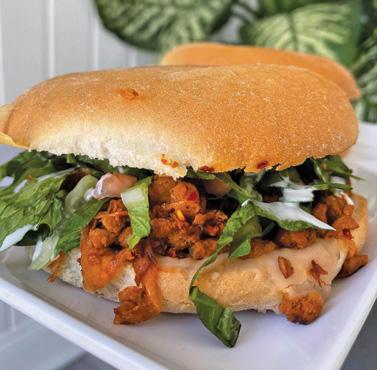
Currently, most of Healthy Substance’s ingredients are made in-house, including the al pastor (which is also sold by the pound). The only exceptions are the carne asada, which is made from Impossible Meat, and the tortillas that are sourced from an external producer. Seasonings and spices are added to the Impossible Meat to give it the avor pro le of traditional Mexican carne asada, Franco says.
REACHING FOR NEW HEIGHTS
Accessibility remains the top priority in the growth plans for Healthy Substance, The Vegan Side of Mexico. With that in mind, Patricia and Franco are considering expansion to Chicago’s gentri ed Wicker Park neighborhood, suburban Naperville, and perhaps a spot on the city’s South Side. They’re also eyeing a more ambitious goal: the retail market and international expansion, particularly to Mexico.
“We’re working on making our own proteins so that we don’t have to rely on Impossible or Beyond. We do this because we want to see a signi cant change in our culture,” says Franco. “If we can’t physically be there with our restaurant, we hope you can still nd our products in the store. That way, eating vegan is made easier.”
Patricia and Franco believe anyone can achieve similar success with a resolute mission. “You need to have that passion to educate your customers. Without that passion, you won’t convince anyone to try your food,” Franco says.
 Paola Ortega is a freelance writer based in Chicago and a new contributor to el Restaurante
Paola Ortega is a freelance writer based in Chicago and a new contributor to el Restaurante
snapshot
“If you ev s our bi boards, the vegan side of Mexico has animals that are fr in a beautiful, vibrant environment,” Franco says. “The oth side do n’t have that. The oth side has ba en land, dried up riv s, slaught , and heart disease.”
ABASTUR es la exposición líder en México y Latinoamérica para proveeduría del sector HORECA.
En donde se reúnen los mejores proveedores de la industria para generar conexiones de negocio.
Conoce las ofertas de productos de las empresas más destacadas y líderes de la industria
Amplía tu red de Networking


Descubre las tendencias del sector
Actualiza tu conocimiento en la conferencias de The Hospitality Summit


¡Te esperamos!
30 de Agosto al 1 de Septiembre 2023
Centro Citibanamex, CDMX
abastur.com
IMMIGRATION CHALLENGES NOT STOPPING Chef Soleil Ramírez
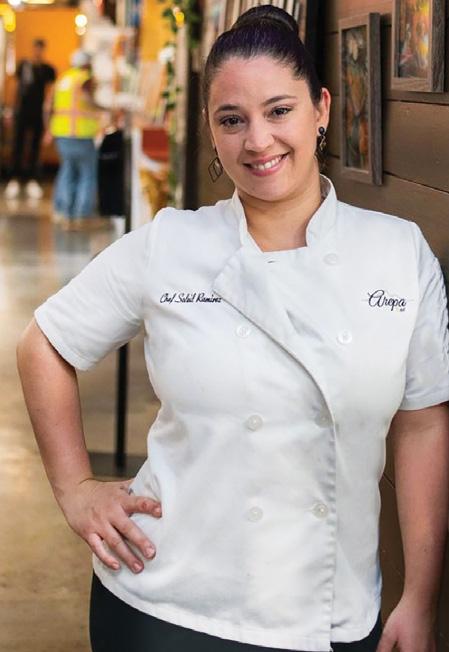 | BY MAXIMILIANO D’ONOFRIO |
| BY MAXIMILIANO D’ONOFRIO |
Chef Soleil Ramírez came to the United States seven years ago as a political refugee from her native Venezuela. Today, less than a decade later, she is about to open Crasquí in St. Paul, Minnesota. It is her second restaurant in the city, coming two years after the early 2021 debut of Arepa Bar at Midtown Global Market, her rst gastronomic venture in the United States.
Soleil’s life has not been easy over the last two decades. First, she had to leave her country of origin; second, she faced all the setbacks that come with being an immigrant even after nding peace in the United States.
“The approval of the building permits took almost ve months. The plan was to open in May, and we are starting to build in the month we were going to open. I had a really hard time getting the funds to open the restaurant because I was a political refugee. I have been here for almost seven years, and I am still waiting for my asylum permit. After a year of struggle, they gave us the last part of the loan,” she comments with an air of exhaustion and satisfaction at the same time.
Crasquí, which will have a ne dining focus, plans to open its doors at the end of July. (A job fair at the location had recently happened as this issue went to press). It’s a

different concept from Arepa, where the idea was to bring a piece of Venezuela through more on-the-go meals typical of Caracas.
With this new project, Ramírez will capture her childhood years traveling through Venezuela with “elevated” dishes. “It is a walk through our culture and the way we cook. The recipes are 100 percent based on my knowledge and experiences,” she says.
SEARCHING FOR INGREDIENTS
Navigating permit and building challenges was a monumental task. But there is another problem Ramírez faces: sourcing ingredients.
“It is very dif cult to get them. You try with what you have and what you can get,” she explains. “The climate here is very different from that of Venezuela, therefore, many things I bring from Texas or Florida. Others, like Venezuelan cheese, for example, are outright illegal here. Our cheese is not pasteurized and here that is illegal.”
The same will happen with sh. “Our sh in Venezuela are from the sea, wild, and here there is no sea. Luckily, I have suppliers that make it much easier for me to obtain them, but I have to pay more for that.”
To accommodate these challenges, Crasquí’s menu will change every four months, allowing Ramírez to use seasonal ingredients and offer some fresh dishes to customers. (continued on page 37)
immigrant stories 34 el restaurante | JULY/AUGUST 2023
“Because of my atus as a political refug , nobody was going to give me $1 mi ion. That is why we l ked for a location wh e a r taurant was already op ating in ord to use what was available and reduce the inv tment.”












See It All at elrestaurante.com Way More News • Tons of Recipes Exclusive Feature Articles
CRUNCHING NUMBERS, ASSEMBLING A TEAM
The distance between Minnesota and Venezuela is not the only problem the chef faces. There are issues speci c to the United States that have forced her to change plans more than once.
“Because of my status as a political refugee, nobody was going to give me $1 million. That is why we looked for a location where a restaurant was already operating in order to use what was available and reduce the investment.”

The chef found a place that met her expectations: bright, with a patio and with the possibility of, after some work, leaving the kitchen open “so that everyone feels included when they come. This has to be an experience,” she says.

At the same time, in ation has made her reconsider numbers several times. “A fork that three months ago cost $5 today it is $7. The same thing a can of Coca-Cola, or the containers to preserve food in refrigerators, which are 30 percent more expensive than not long ago. I modi ed the budget more than once,” Ramírez says.
Hiring and preparing her team is also a major pillar of the project. Ramírez plans to serve 150 people; to provide a suitable service she will need a team of 35 people.
“Salaries after the pandemic went up a lot,” she says. “It is said that the payroll cannot normally be more than 30 percent, and nowadays no restaurant should be below 42 percent.”
Although her years of experience in her industry have given her people who want to work with her again, she understands that “you can’t take people without experience for an opening.
“I must train them all,” she stresses. “I don’t expect the team to work perfectly from one day to the next, but the restaurant’s guidelines must be followed. I spent many years on the other side and mistreatment will not be tolerated here. I have seen chefs humiliate their cooks and that has no place with me. We are humans, not numbers.”
Perhaps these values have served as a guide on a dif cult path, far from home. Ramírez had to ee Venezuela, leaving behind not only her material possessions but also what cannot be bought: love and contact with loved ones.
“I ght every day to get my mother out of there, since I cannot return to my country. I could with my brother, I couldn’t with my father [who has passed away], but I still dream of getting her out of Venezuela,” Ramírez says. “I’ve seen her once in the last seven years. I am stubborn and persevering, and that pain is my fuel.”
JULY/AUGUST 2023 | el restaurante 37
immigrant stories
Maximiliano D’Onofrio is a freelance writer who regularly contributes to el Restaurante.
LOS DESAFÍOS DE LA INMIGRACIÓN NO DETIENEN
a la chef Soleil Ramírez

| POR MAXIMILIANO D’ONOFRIO |
La chef Soleil Ramírez llegó a Estados Unidos hace siete años como refugiada política desde su natal Venezuela. Hoy, menos de una década después, está a punto de abrir Crasquí en St. Paul, Minnesota. Es su segundo restaurante en la ciudad, después de que a principios de 2021 inaugurara Arepa Bar en el Midtown Global Market, su primera aventura gastronómica en Estados Unidos.
La vida de Soleil no ha sido fácil en las dos últimas décadas. Primero, tuvo que abandonar su país de origen; segundo, se enfrentó a todos los contratiempos que conlleva ser inmigrante, incluso después de encontrar la paz en Estados Unidos.
“La aprobación de los permisos de construcción tardó casi cinco meses. El plan era abrir en mayo, pero empezamos a construir el mismo mes en que pensábamos inaugurarlo. Me costó mucho conseguir los fondos para abrir el restaurante porque era una refugiada política. Llevo aquí casi siete años y sigo esperando mi permiso de asilo. Después de un año de lucha, nos dieron la última parte del préstamo”, comenta con un aire de cansancio y satisfacción al mismo tiempo.
Crasquí, que se centrará en la buena gastronomía, tiene previsto abrir sus puertas a nales de julio. (Al cierre de esta edición se había celebrado una feria de empleo en el local). Se trata de un concepto distinto al de

Arepa, donde la idea era llevar un pedazo de Venezuela en comidas para llevar típicas de Caracas.
Con este nuevo proyecto, Ramírez plasmará sus años de infancia viajando por Venezuela con platos “ dealtura”. “Es un paseo por nuestra cultura y nuestra forma de cocinar. Las recetas están 100% basadas en mis conocimientos y experiencias”, asegura.
EN BUSCA DE INGREDIENTES
Sortear los problemas de permisos y construcción fue una tarea monumental. Pero hay otro problema al que se enfrenta Ramírez: la búsqueda de ingredientes.
“Es muy difícil conseguirlos. Lo intentas con lo que tienes y con lo que puedes conseguir”, explica. “El clima aquí es muy diferente al de Venezuela, por lo tanto, muchas cosas las traigo de Texas o Florida. Otras, como el queso venezolano, por ejemplo, es totalmente ilegal aquí. Nuestro queso no está pasteurizado y aquí eso es ilegal”.
Lo mismo ocurre con el pescado. “Nuestro pescado en Venezuela es de mar, es silvestre, y aquí no hay mar. Por suerte, tengo proveedores que me facilitan mucho su adquisición, pero tengo que pagar más por ello.”
Para adaptarse a estos retos, el menú de Crasquí cambiará cada cuatro meses, lo que permitirá a Ramírez utilizar ingredientes de temporada y ofrecer platos frescos a los clientes.
38 el restaurante | JULY/AUGUST 2023
immigrant stories
“Por mi condición de refugiado político, nadie me iba a dar $ 1 mi ón Es por o que buscamos un lugar donde ya tuvi a funcionando un r taurante en para usar lo que taba disponible y reducir la inv sión.”
HACIENDO NÚMEROS, FORMANDO UN EQUIPO
La distancia entre Minnesota y Venezuela no es el único problema al que se enfrenta la chef. Hay aspectos especí cos de Estados Unidos que la han obligado a cambiar de planes más de una vez.
“Debido a mi condición de refugiada política, nadie iba a darme un millón de dólares. Por eso buscamos un local donde ya operara un restaurante, para aprovechar lo que estaba disponible y reducir la inversión.”

La chef encontró un local que cumplía con sus expectativas: luminoso, con patio y con la posibilidad de, después de algunas obras, dejar la cocina abierta “para que todo el mundo se sintiera incluido cuando acudiera. Esto también tiene que ser una experiencia”, a rma.

Al mismo tiempo, la in ación la ha hecho replantearse los números varias veces. “Un tenedor que hace tres meses costaba 5 dólares, hoy cuesta 7. Lo mismo una lata de Coca-Cola o los envases para conservar los alimentos en los refrigeradores, que son un 30% más caros que no hace mucho. He modicado el presupuesto más de una vez”, dice Ramírez.
Contratar y preparar a su equipo también es un eje importante del proyecto. Ramírez planea atender a 150 personas; para prestar un servicio
adecuado necesitará un equipo de 35 personas.
“Los sueldos después de la pandemia subieron mucho”, dice. “Se dice que la nómina normalmente no puede ser superior al 30 por ciento, y hoy en día ningún restaurante debería estar por debajo del 42 por ciento”.
Aunque sus años de experiencia en el sector le han dado gente que quiere volver a trabajar con ella, entiende que “no se puede contratar a gente sin experiencia para una vacante”.
Aunque sus años de experiencia en su sector le han recompensado con gente que quiere volver a trabajar con ella, entiende que “no se puede contratar a gente sin experiencia para una inauguración”.
“Debo formarlos a todos”, subraya. “No espero que el equipo funcione a la perfección de un día para otro, pero hay que seguir las directrices del restaurante. Pasé muchos años en el otro lado y aquí no se tolerará el maltrato. He visto a chefs humillar a sus cocineros y eso no tiene cabida conmigo. Somos humanos, no números”.
Quizá estos valores le han servido de guía en un camino difícil, lejos de casa. Ramírez tuvo que huir de Venezuela, dejando atrás no solo sus posesiones materiales, sino también lo que no se puede comprar: el amor y el contacto con los seres queridos.
“Lucho cada día para sacar a mi madre de allí, ya que no puedo volver a mi país. Pude con mi hermano, no pude con mi padre [que ya falleció], pero sigo soñando con sacarla de Venezuela”, dice Ramírez. “La he visto una vez en los últimos siete años. Soy terca y perseverante, y ese dolor es mi combustible”.
Maximiliano D’Onofrio es un escritor independiente que colabora regularmente con el Restaurante
JULY/AUGUST 2023 | el restaurante 39
Taking Cocktail Flights TO NEW HEIGHTS
| BY ELYSE GLICKMAN | Like tequila and mezcal ights, which took off a little more than a decade ago, cocktail ights can broaden the scope of customers’ dining adventures. They also let members of your bartending crew ex their creative muscles and spark conversations between servers and customers about what your bar has to offer.
Whether using ights to educate customers on different brands or expressions of the same spirit, or to showcase seasonal fruits and avor trends, the ultimate destination is a bottom line boosted by new and returning cocktail customers.
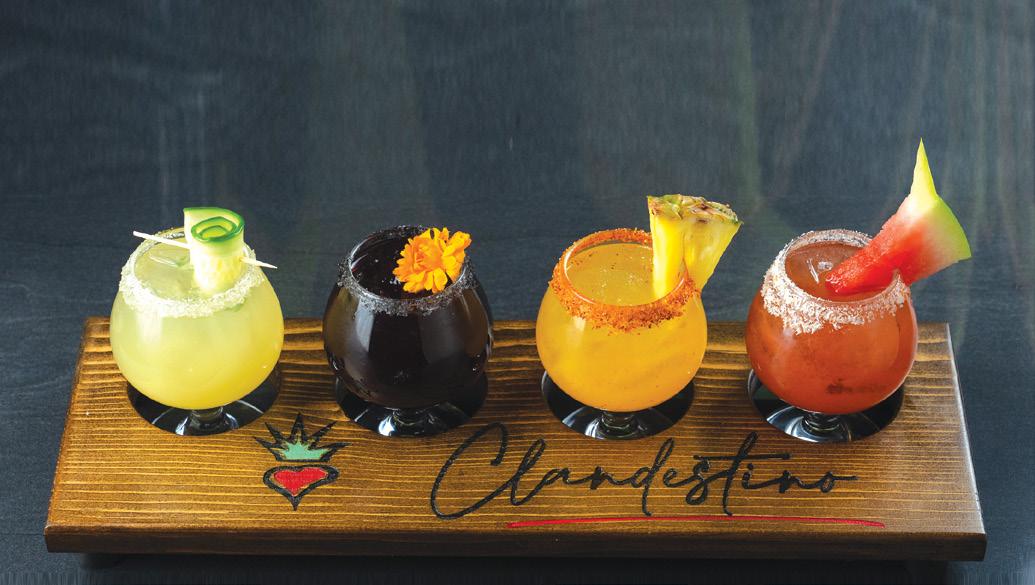

“Offering cocktail ights is a combination of a popular trend and a clever marketing strategy,” says Miguel Hernandez, president of Rreal Tacos restaurants in Atlanta, Georgia. “They appeal to customers who enjoy trying different drinks and showcase the bartenders’ skills while highlighting the variety of spirits available. They can create higher perceived value, they can enhance pro tability, and they can also work with food pairings, creating a better overall experience.”
PLANNING THE FLIGHT PATH
“Everyone wants to be creative, and the margarita, piña colada, and mojito ights we offer allow bartenders to shine and customers to have a unique experience,” says Alex Hult, CEO of the aptly named Flights Restaurant Group, whose aviationthemed restaurants in the Bay Area and Las Vegas also feature taco and empanada ights on the food menu. “Our bars and kitchens work closely, as the interaction allows the bartenders
to experiment and use up products the kitchen does not want to go to waste.”
For Flights restaurant in Las Vegas, that path includes a daily happy hour menu featuring different ights throughout the day: Mimosa and Bloody Mary ights from 9 am to noon; beer and wine ights from noon to 3 pm; cocktail ights from 3 pm to 6 pm; and beer and wine ights from 6 pm to close.
Katerina Coumbaros, co-founder of Meraki Food Group, which owns Kavas Tacos + Tequila in Orlando, Florida, says the restaurant is rolling out a Cocktail Tree that features multiple tequila-based spritzes — “the perfect refreshment for the Florida weather,” Coumbaros says. “It can also help our staff upsell and increase check averages. It can also be a great way to create multiple uses of the ingredients we are making in-house or sourcing.”
Coumbaros says Kavas’ ights also keep bartenders sharp
40 el restaurante | JULY/AUGUST 2023 at the bar
Gracias Madre’s Raspado Guava
Tito my ‘Rita
A DELICIOUS TWIST ON A FAN - FAVORITE GO AHEAD, SHAKE THINGS UP.
2 OZ TITO’S HANDMADE VODKA

½ OZ ORANGE LIQUEUR
2 OZ LIME JUICE
¼ OZ AGAVE
Add all ingredients to a shaker with ice. Shake and strain into a glass with or without fresh ice. Garnish with a lime slice.
Pro-Tip: If you like it salty, use a glass with a salted rim.
SCAN FOR MORE TITO’S COCKTAIL RECIPES
The Social Side of Cocktail Flights
Cocktail flights on the ‘Flights’ menu as well as other Mexican-focused restaurants around the country are making waves on social media. Katerina Coumbaros, the co-founder of Meraki Food Group, which owns Kavas Tacos + Tequila in Orlando, FL, notes that when a flight is dressed up with a “social media look” and photos are broadcast over Instagram and TikTok, the exposure will pull in an ever-expanding audience of curious trendseeking diners and imbibers.
“If the flight offers a ‘wow’ factor or ‘social-media look’ that we love, it’s a great way to get people talking about us online,” Coumbaros says.
Jonathan Garcia, bar spokesman for Tac/Quila and Clandestino in Palm Springs, says social media — Instagram in particular — has helped the restaurants build sales of cocktail flights, which average 50 to 60 daily. “There’s also the ‘wow’ factor in our presentation involving small snifter glasses and our logo,” Garcia says. “This appears in beautiful social media photos, generating interest among new and existing customers.”
while giving an advantage to waitstaff who want to better communicate with the customers about what makes the bar and food menus special. And while most customers are wellinformed about different tequila expressions, she says cocktail ights take the experience to a different but equally enlightening place.
“While people understand the three main categories of tequila, they may not know how each one complements speci c ingredients or how they taste in comparison,” she says. “There’s never any ‘wrong’ way to go; a permanent ight offering doesn’t necessarily mean the avors have to be permanent. Changing up the ight components seasonally is a great way to utilize the freshest ingredients, allow bartenders to weigh in and be creative on new options, and provide new options to market to your customers on social media.”
In Palm Springs, California, Jonathan Garcia, bar spokesman for both Tac/Quila and Clandestino, estimates that hundreds of the restaurants’ cocktail ights — which change seasonally — are ordered daily at both venues.

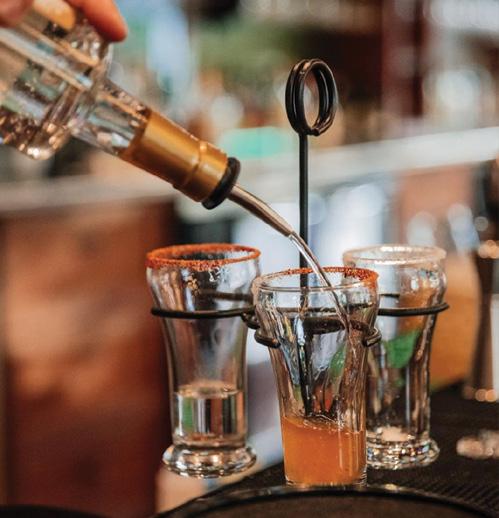
“When we batch, we do about four to ve gallons a day, with each gallon yielding 25 cocktails…and we sell an average of 50 to 60 ight boards daily,” Garcia reports. He stresses that ights are particularly helpful when dealing with
customers who can’t decide which cocktail they want.
Customers unsure of which margarita to order, for example, can sample multiple options with the restaurants’ Flight of 4 Tasting Size Margaritas that includes Pineapple Passion, Spicy Cucumber, Watermelon Tamarindo, and Jamaica versions of the cocktail. The ights are offered at both Tac/Quila and Clandestino. As the menu says, “Who says you have to pick one? Try these four.”
“Customers order the ight, and on a future visit, gravitate toward the drink or drinks that really spoke to them,” Garcia says.
Sean Stewart, beverage director at Gracias Madre in Newport Beach, California, agrees that cocktail ights showcase a “bartender’s ability to tell a story through avor.” The restaurant’s distinctive twist on ights is offering small, cocktail versions of traditional Mexican raspados — shaved ice treats made with fresh fruit, avorful syrups and sweet toppings. Examples include the guava, Herradura Blanco, seasonal fruit and cranberry-apricot chamoy raspado; one made with watermelon, mint, La Tierra De Acre Cenizo Mezcal, Cointreau and pink peppercorn, served with a pineapple popsicle; and the El Tequileno Reposado featuring cacao, clove, California dates and vanilla oat milk ice cream.
“CUSTOMERS ORDER THE FLIGHT, AND ON A FUTURE VISIT, GRAVITATE TOWARD THE DRINK OR DRINKS THAT REALLY SPOKE TO THEM.” JONATHAN GARCIA, TAC/QUILA AND CLANDESTINO
42 el restaurante | JULY/AUGUST 2023
Rreal Tacos’ Margarita Flight
Flights’ Bloody Mary Flight

ECONOMY VS. FIRST CLASS
Rreal Tacos’ Hernandez believes the suitability of cocktail ights depends on a restaurant’s goals and dynamics. “(Our) ight pricing is in uenced by the cost of spirits and ingredients, including those grown in-house or from artisanal producers,” Hernanez says. “Bartenders’ workload is also increased when making a ight, but the effort is well worth it.”
“We price our ights at Tac/Quila and Clandestino at around $23, which is the equivalent of a cocktail and a half, but presents our customers four different varieties,” says Garcia. “The value lies in the selection for the customers, the presentation with the wood board and snifter glasses, and the drinks’ versatility as they pair well with our food.”
Coumbaros emphasizes that customers pay a bit less for cocktail ights at Kavas Tacos + Tequila than they would if ordering the same number of drinks individually. Even so, a big part of the value is the aesthetics, so extra effort is put into garnishes that add to the drink rather than just decorate it.
“We make sure we use fresh herbs grown in-house, organic edible owers, and beautifully cut fruit when putting the nal touches on a drink,” she says.
“A great deal of thought goes into pricing our drink ights,” says Hult when discussing how Flights determines the valueto-price ratio. “We use artisanal spirits and fresh produce that cost more, but there is also more preparation time as the mixologist is making three different drinks. Once the bartenders get used to making the drink, however, it’s very successful. This is important as liquor sales are 75 percent of our total alcohol sales, whereas elsewhere, it’s more like 60 percent wine, 20 percent beer, and 20 percent liquor.”
Garcia and his teams at Tac/Quila and Clandestino go through a trial-and-error process when developing individual cocktails as well as a new stand-out ight every season. While
management has the nal say, customer feedback is important. Garcia also includes the kitchen manager in the process, discussing what fruits will make the best ingredients for the various margaritas, as well as juices and syrups. Each season the menu includes a sweet selection, one that’s tart and refreshing, and a couple of ights in between that re ect what’s in season.
“I’ll do a cocktail-of-the-week during the off-season (summer) that is potentially something for the next cocktail menu that will also be considered for the upcoming ight,” he says. “After I get our customers’ input along with the managers’ input, (the team) will work on whatever is not working in that week’s cocktail. From there, I will do my cocktail presentations for our managers’ approval. This assures we will be completely ready for the start of our high/busy season in September.”
HOW AND WHEN TO STAY GROUNDED
While Gracias Madre’s Stewart acknowledges that ights can be great for the bottom line, they may add to an already busy night and slow down service.
“I think cocktail ights are best used sparingly,” he says. “Bartenders already have so much to do, (and) this is why we program our ights a bit differently at Gracias Madre, offering it as a shared experience a group of friends can enjoy.”
At Clandestino, “bartenders show up early because they need to get cocktails in the current ight pre-batched,” says Elizabeth Pezchica, general manager.
Workload is top of mind at Kavas Tacos + Tequila, too. “Our bartenders are used to making three to four drinks per order, we try to keep our ight-sized cocktails no more workintensive than any three to four full-sized cocktails as to not create a backup at the bar,” Coumbaros says.
Ultimately, when it comes to ights from the bar, the preight prep is as important as the destination. As these chefs and mixologists know, success is a matter of packing the right elements, working within a budget, and having a rm idea of where your customers want to travel on their cocktail journey.
See recipes for the flightappropriate Mexican Aperol Spritz from Kavas Tacos + Tequila and Raspados from Gracias Madre on page 63.

Los Angeles-based writer Elyse Glickman is the At the Bar columnist for el Restaurante

44 el restaurante | JULY/AUGUST 2023
Flights’ Mimosa Flight
Kavas Tacos + Tequila’s Aperol Spritz Tree
Llevar las catas de cócteles A NUEVOS TERRENOS
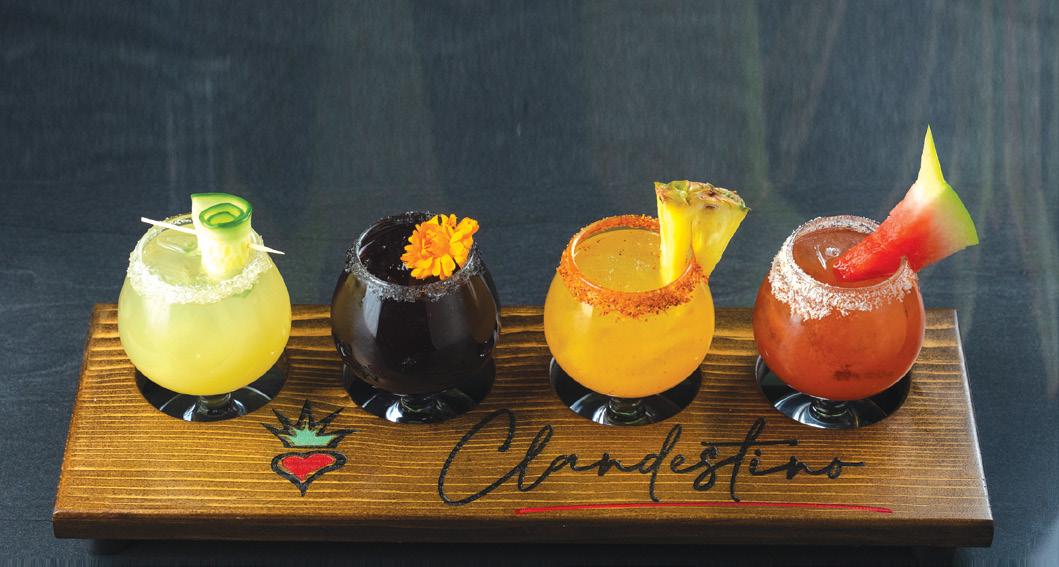
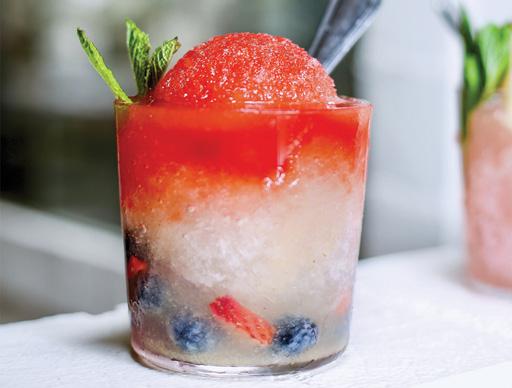
| POR ELYSE GLICKMAN | Al igual que las catas de tequila y mezcal, que despuntaron hace poco más de una década, las catas de cócteles pueden ampliar el alcance de las aventuras gastronómicas de los clientes. También permiten a los bartenders dar rienda suelta a su creatividad y suscitar conversaciones entre bartenders y clientes sobre lo que ofrece el bar.
Tanto si se utilizan las catas para educar a los clientes sobre diferentes marcas o expresiones de una misma bebida alcohólica, como para mostrar las frutas de temporada y las tendencias de sabor, el objetivo nal es un balance nal impulsado por los clientes de cócteles nuevos y los que regresan.
“Ofrecer catas de cócteles es una combinación de una tendencia popular y una inteligente estrategia de marketing”, a rma Miguel Hernández, presidente de los restaurantes Rreal Tacos de Atlanta (Georgia). “Atraen a los clientes que disfrutan de probar bebidas diferentes y muestran las habilidades de los bartenders al tiempo que ponen de relieve la variedad de bebidas alcohólicas disponibles. Pueden crear un mayor valor percibido, pueden mejorar la rentabilidad y también pueden funcionar con maridajes de comida, creando una mejor experiencia global.”
PLANEAR LA TRAYECTORIA DE ESTRATEGIA
“Todo el mundo quiere ser creativo, y las catas de margarita, piña colada y mojito que ofrecemos permiten a los bartenders brillar y a los clientes vivir una experiencia única”, dice Alex Hult, director ejecutivo del acertadamente llamado Flights Restaurant Group, cuyos restaurantes de temática aeronáutica en San Francisco y Las Vegas también ofrecen catas de tacos y
empanadas en el menú de comida. “Nuestros bares y cocinas trabajan en estrecha colaboración, ya que la interacción permite a los bartenders experimentar y utilizar productos que la cocina no quiere que se desperdicien”.
Para el restaurante Flights de Las Vegas, ese camino incluye un menú diario de happy hour con diferentes catas a lo largo del día: Catas de mimosa y Bloody Mary de 9:00 a 12:00; catas de cerveza y vino de 12:00 a 15:00; catas de cóctel de 15:00 a 18:00; y catas de cerveza y vino de 18:00 a cierre.
Katerina Coumbaros, cofundadora de Meraki Food Group, propietaria de Kavas Tacos + Tequila en Orlando (Florida), dice que el restaurante está poniendo en marcha un Árbol de Cócteles con varios spritzes a base de tequila, “la bebida refrescante perfecta para el clima de Florida”, dice Coumbaros. “También puede ayudar a nuestro personal a vender más y aumentar el promedio del total de la cuenta. También puede ser una buena forma de dar múltiples usos a los ingredientes que preparamos o adquirimos”.
en el bar
Raspado Guava de Gracias Madre
El lado social de los cócteles
Las catas de cócteles del menú “Flights” y de otros restaurantes de cocina mexicana del país están causando sensación en las redes sociales. Katerina Coumbaros, cofundadora de Meraki Food Group, propietaria de Kavas Tacos + Tequila en Orlando (Florida), señala que cuando una cata se presenta con un “look de redes sociales” y se difunden fotos en Instagram y TikTok, la exposición atrae a un público cada vez más amplio de comensales y bebedores curiosos y ávidos de tendencias.
“Si la cata ofrece un factor sorpresa o un ‘look de redes sociales’ que nos encanta, es una forma estupenda de conseguir que la gente hable de nosotros en Internet”, afirma Coumbaros.
Jonathan García, portavoz de los bares Tac/Quila y Clandestino de Palm Springs, afirma que las redes sociales, en particular Instagram, han ayudado a los restaurantes a aumentar las ventas de catas de cócteles, que alcanzan un promedio de 50 a 60 al día. “También está el factor sorpresa de nuestra presentación, que incluye pequeñas copas de coñac y nuestro logotipo”, dice García. “Esto aparece en hermosas fotos de redes sociales, generando interés entre los clientes nuevos y existentes”.
Coumbaros a rma que las catas de Kavas también ayudan a los bartenders a mantenerse al día y a los meseros a comunicarse mejor con los clientes sobre lo que hace especiales los menús del bar y la comida. Y aunque la mayoría de los clientes están bien informados sobre las distintas expresiones del tequila, a rma que las catas de cócteles llevan la experiencia a un lugar diferente pero igualmente esclarecedor.
“Aunque la gente conoce las tres categorías principales de tequila, puede que no sepa cómo complementa cada una a ingredientes especí cos o cómo saben en comparación”, a rma. “Nunca hay un camino ‘equivocado’; una oferta permanente no signi ca necesariamente que los sabores tengan que ser permanentes. Cambiar los componentes de la carta cada temporada es una forma estupenda de utilizar los ingredientes más frescos, permitir que los bartenders opinen y sean creativos en las nuevas opciones, y ofrecer nuevas opciones para promocionar a sus clientes en las redes sociales.”
En Palm Springs, California, Jonathan García, portavoz de los bares Tac/Quila y Clandestino, calcula que en ambos locales se piden a diario cientos de catas de cócteles de los restaurantes, que cambian según la temporada.
“Cuando hacemos lotes, hacemos de cuatro a cinco galones al día, y cada galón rinde 25 cócteles... y vendemos un promedio de 50 a 60 tablas de catas al día”, explica García. Destaca que las catas son especialmente útiles cuando los clientes no se deciden por un cóctel.
Los clientes que no estén seguros de qué margarita pedir,
por ejemplo, pueden probar varias opciones con la Cata de 4 Margaritas de Degustación de los restaurantes, que incluye las versiones Piña Pasión, Pepino Picante, Sandía Tamarindo y Jamaica del cóctel. Las catas se ofrecen tanto en Tac/Quila como en Clandestino. Como dice el menú: “¿Quién dice que tienes que elegir uno? Prueba estos cuatro”.
“Los clientes piden la cata y, en una próxima visita, se decantan por la bebida o bebidas que más les han gustado”, dice García.
Sean Stewart, director de bebidas de Gracias Madre, en Newport Beach, California, está de acuerdo en que los cócteles combinados demuestran “la capacidad del bartender para contar una historia a través del sabor”. El toque distintivo de las catas del restaurante consiste en ofrecer pequeñas versiones en cóctel de los tradicionales raspados mexicanos, delicias de hielo raspado hechas con fruta fresca, jarabes sabrosos y toppings dulces. Algunos ejemplos son el raspado de guayaba, Herradura Blanco, fruta de temporada y chamoy de arándanos y chabacano; uno hecho con sandía, menta, Mezcal Cenizo La Tierra De Acre, Cointreau y pimienta rosa, servido con una paleta helada de piña; y el El Tequileno Reposado con cacao, clavo, dátiles de California y helado de leche de avena y vainilla.
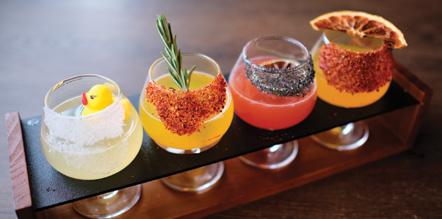

TURISTA CONTRA PRIMERA CLASE
Hernández, de Rreal Tacos, cree que la idoneidad de las catas de cócteles depende de los objetivos y la dinámica del
46 el restaurante | JULY/AUGUST 2023
Margarita Flight de Rreal Tacos
Bloody Mary Flight de Flights
restaurante. “(Nuestro) precio de las catas está in uido por el costo de los licores y los ingredientes, incluidos los de cultivo propio o de productores artesanales”, dice Hernánez. “La carga de trabajo de los bartenders también aumenta al hacer una cata, pero el esfuerzo merece la pena”.
“El precio de nuestras catas en Tac/Quila y Clandestino ronda los 23 dólares, lo que equivale a un cóctel y medio, pero presenta a nuestros clientes cuatro variedades diferentes”, dice García. “El valor reside en la selección para los clientes, la presentación con la tabla de madera y las copas de coñac, y la versatilidad de las bebidas, ya que maridan bien con nuestra comida”.
Coumbaros subraya que los clientes pagan un poco menos por las catas de cócteles en Kavas Tacos + Tequila de lo que pagarían si pidieran el mismo número de bebidas individualmente. Aun así, gran parte del valor reside en la estética, por lo que se pone un esfuerzo extra en los adornos que aportan algo a la bebida en lugar de simplemente decorarla.

“Nos aseguramos de utilizar hierbas frescas de cultivo propio, ores comestibles ecológicas y fruta cortada a conciencia para dar los toques nales a la bebida”, explica.
“Pensamos mucho en el precio de nuestras catas de bebidas”, dice Hult al hablar de cómo Flights determina la relación calidad-precio. “Utilizamos licores artesanales y productos frescos que cuestan más, pero también hay más tiempo de preparación, ya que el bartender prepara tres bebidas diferentes. Sin embargo, una vez que los bartenders se acostumbran a preparar la bebida, tiene mucho éxito. Esto es importante, ya que las ventas de licores suponen el 75 % de nuestras ventas totales de alcohol, mientras que en otros sitios es más bien el 60 % de vino, el 20 % de cerveza y el 20 % de licores”.
García y sus equipos de Tac/Quila y Clandestino pasan por un proceso de prueba y error a la hora de desarrollar cócteles individuales, así como una nueva cata destacada cada temporada. Aunque la dirección tiene la última palabra, la opinión de los clientes es importante. García también incluye al jefe de cocina en el proceso, discutiendo qué frutas serán los mejores ingredientes para las distintos margaritas, así como jugos y jarabes. Cada temporada, el menú incluye una selección dulce, otra ácida y refrescante, y un par de
margaritas intermedias que re ejan la temporada.
“Durante la temporada baja (el verano), preparo un cóctel de la semana que puede servir para el siguiente menú de cócteles y que también se tendrá en cuenta para la próximo cata”, explica. “Después de recibir la opinión de los clientes y de los gerentes, el equipo trabajará en lo que no funcione en el cóctel de esa semana. A partir de ahí, hago las presentaciones de los cócteles para que los jefes las aprueben. Así nos aseguramos de estar completamente listos para el inicio de nuestra temporada alta en septiembre”.
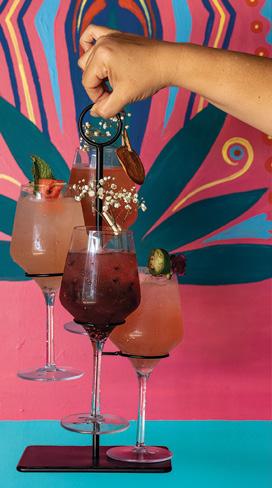
CÓMO Y CUÁNDO MANTENER LOS PIES EN LA TIERRA
Stewart, de Gracias Madre, reconoce que las catas pueden ser muy bene ciosas para el balance nal, pero pueden complicar una noche ya de por sí ajetreada y retrasar el servicio.
“Creo que las catas de cócteles es mejor utilizarlas con moderación”, a rma. “Los bartenders ya tienen mucho que hacer, (y) por eso programamos nuestras catas de forma un poco diferente en Gracias Madre, ofreciéndolas como una experiencia compartida que un grupo de amigos puede disfrutar”.
En Clandestino, “los bartenders llegan temprano porque tienen que tener preparadas las catas de cócteles en curso”, dice Elizabeth Pezchica, directora general de Clandestino.
En Kavas Tacos + Tequila, también se tiene muy en cuenta la carga de trabajo. “Nuestros bartenders están acostumbrados a hacer de tres a cuatro bebidas por pedido, intentamos que nuestros cócteles de tamaño de las catas no requieran más trabajo que tres o cuatro cócteles de tamaño completo para no crear un retraso en la barra”, dice Coumbaros
En última instancia, cuando se trata de catas desde el bar, la preparación previa a la cata es tan importante como el destino nal. Como saben estos chefs y bartenders, el éxito es cuestión de llevar los elementos adecuados, trabajar dentro de un presupuesto y tener una idea rme de qué quieren sus clientes en su cata de cócteles.
Consulte las recetas del Aperol Spritz Mexicano de Kavas Tacos + Tequila y Raspados de Gracias Madre en la página 63.
JULY/AUGUST 2023 | el restaurante 47
Elyse Glickman, escritora afincada en Los Ángeles, es columnista de At the Bar para el Restaurante.
Mimosa Flight de Kavas + Tequila
Flights’ Mimosa Flight

AVILA’S
EL RANCHITO:
Guidelines for Growing a Multi-Family, Multi-Location Restaurant
| BY ED AVIS |
When Salvador Avila opened Avila’s El Ranchito Mexican Restaurant in Huntington Park, California in 1966, he planted the seed for what today is a beloved 13-location restaurant that involves 45 family members across three generations. The success of this family-owned enterprise has not been due to luck: The Avilas follow a set of guidelines that help ensure quality experiences for customers, pro t in the bottom line, and harmony among family members.



“We’re family before we’re a business,” says Bianca Avila Small, one of Salvador’s granddaughters, who helps run the locations in Corona Del Mar, Huntington Beach and Newport Beach.
Why has this family business succeeded? Here are ve reasons Avila’s has prospered over the past six decades.
1Clear Roles for Family Members.
Family business consultants stress that having clear roles for each family member is important to maintaining harmony. The Avilas accomplished this by making sure all locations are not owned by a single corporate entity. Instead, various family members own one or more locations separately from the others.
“Everyone owns their own location, operates [in] their own style, and that’s what’s helped us stay successful as a family and as business owners,” Small says. “Because as you know, every person has a different personality and different style and way of running things.”
2
Established Guidelines, Recipes and Standards. Even though the restaurants are separately owned, maintaining the overall brand requires standards that everyone must follow. In the mid 1980s, when the second generation began opening locations, the Avilas developed a set of guidelines that covers recipes, marketing, and business issues.
For example, all locations use the same recipes for key dishes, including Mama Avila’s Soup, the rice and beans, the meats and the salsas. Beyond the essential recipes, however, each location is free to innovate.
For example, the Laguna Beach location, owned by Small’s cousin Michael Avila, has salmon tacos on the menu, which suits that beach community. And Small’s cousin Natalie Ruttkay, who runs the Lake Forest and Foothill locations, has developed a popular vegetarian menu.
On the marketing side, the logo and menu design are standardized, and the locations share a website and Facebook page, but the locations otherwise are free to market on their own.
The guidelines extend to business growth. If a family member wants to open a new location, he or she must have a college degree, a business plan that is approved by owners, and a proposed site that is not too close to an existing location.
“And we expect that you go through all the proper training through one of the locations and know the recipes,” Small explains. “We should all work in the restaurant from the bottom up, starting as hostess and then server and manager and
JULY/AUGUST 2023 | el restaurante 49
“When Christmas comes around, we’re not talking to each other about important day-to-day [business] things because we’ve already had that family meeting… I think separating family time and business time is a really big part of what keeps us a family . ”
business basics
BIANCA AVILA SMALL
Other Issues to Consider
There are myriad issues to consider when growing a family business, as the Avila family explained quite well. In addition to the tips they shared, Henry Dominguez, Jr., owner of FoodPro Restaurant Consulting, LLC, offers three additional areas families should consider when growing a family-owned restaurant.
Establish rules about job sharing/ transferring employees between all locations. Can an employee leave one restaurant to work for another? Also consider confidentiality or non-compete agreements for family members.
Create purchasing/standards specifications Will locations all buy the same products from the same suppliers? What standards and controls need to be set to make sure the quality remains the same at each location?
Discuss how to handle intellectual property Ensure that everyone is on the same page regarding the essential characteristics of the restaurant, such as proprietary recipes, food preparation procedures, etc. Which of these will every restaurant have to adopt?
cook, just knowing how the restaurant is run from the bottom up.”
3Frequent Communication. The Avilas regularly share purchasing information, employee needs, and other issues. Prior to Covid, the family met in-person monthly; those meetings have not resumed at the same pace, but group texts and emails have lled the void.
“We talk about business ideas and how to improve operations,” Small explains. “Did we have any issues with suppliers lately? Who likes their produce, and from who are we buying? Does anyone have ideas for new menu items? We help each other out if someone’s looking for a manager or bartenders, and they say, ‘Hey, if anyone gets any applications for bartenders, please send them my way because we need a bartender.’”
The family meets in-person when restaurant-wide decisions must be made. For example, if an owner wants to create a new menu design, family approval is required. If opinions differ, the family votes, “or we table the idea for the next meeting,” Small explains.
4Separate Work and Family Time. Regular group texts and in-person meetings during business hours mean the Avilas can stop discussing business during family time. It may seem impossible that a family that owns 13 restaurants could avoid shop talk during social events, but Small says they do.
5Professional Help When Needed.
Sometimes a family business needs outside help. For the Avilas, that point came when the second generation started getting heavily involved.
“It was in the ‘80s when they realized, ‘OK, we’ve got a good thing going here. How are we going to continue this for future generations?’” Small says. “So, they reached out to the right people to guide them in the right direction.”
The family found a consultant who helped them see the future of the business.
“I think a big thing that has helped us has been to have a consultant — a small family business consultant — to analyze our business, talk to each individual family member and understand what their wants and needs are, and understand their operating style, and help us gure out how we can all work together and moderate those rst few meetings so you’re all in the same plan,” Small says. “After the family kind of gures out what works, then you can go from there. But I think having a consultant has been a huge help.”
The guidelines and practices the Avilas have undertaken have helped them grow a single restaurant into a successful enterprise that could continue to grow with the generations. The Avilas have leveraged their family connections to help each other.
Mama Avila’s Soup
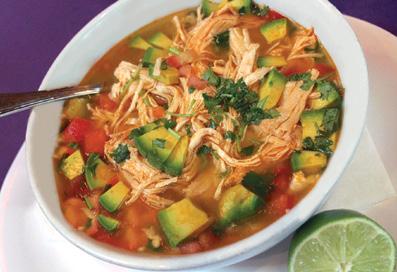
“When Christmas comes around, we’re not talking to each other about important day-to-day [business] things because we’ve already had that family meeting,” she says. “We already discussed what we needed to discuss. I think separating family time and business time is a really big part of what keeps us a family.”
“While they’re all individually owned, we all still support each other, help each other, bounce ideas off of each other,” she says, adding that customers appreciate the family feel of the restaurants. “Our regular customers love coming in and feeling like a part of the family, and we treat them like family. They see us as family, and our restaurants are part of their family traditions as well.”
Ed Avis is the publisher of el Restaurante.
50 el restaurante | JULY/AUGUST 2023 business basics
AVILA’S EL RANCHITO:
Pautas para explotar un restaurante multifamiliar con varios locales
| POR ED AVIS | Cuando Salvador Avila abrió el restaurante mexicano Avila’s El Ranchito en Huntington Park, California, en 1966, plantó la semilla de lo que hoy es un querido restaurante con 13 locales en el que participan 45 miembros de la familia a lo largo de tres generaciones. El éxito de esta empresa familiar no se ha debido a la suerte: los Avila siguen una serie de pautas que ayudan a garantizar experiencias de calidad para los clientes, bene cios en la cuenta de resultados y armonía entre los miembros de la familia.
“Somos una familia antes que un negocio”, a rma Bianca Avila Small, una de las nietas de Salvador, que ayuda a dirigir los locales de Corona Del Mar, Huntington Beach y Newport Beach.

¿Por qué ha triunfado este negocio familiar? Estas son cinco razones por las que Avila’s ha prosperado en las últimas seis décadas.
1Roles claros para los miembros de la familia. Los consultores de empresas familiares destacan que tener claras las funciones de cada miembro de la familia es importante para mantener la armonía. Los Avila lo lograron asegurándose que todos los locales no fueran propiedad de una única entidad corporativa. En su lugar, varios miembros de la familia son propietarios de uno o más locales independientes de los demás.
“Cada uno es propietario de su propio local, actúa con su propio estilo, y eso es lo que nos ha ayudado a mantener el
éxito como familia y como propietarios de un negocio”, a rma Small. “Porque como usted sabe, cada persona tiene una personalidad diferente y un estilo y una forma de llevar las cosas distintos”.
2Pautas, recetas y normas establecidas. Aunque los restaurantes son de propietarios independientes, el mantenimiento de la marca global requiere unas normas que todos deben seguir. A mitad de la década de 1980, cuando la segunda generación comenzó a abrir locales, los Avila desarrollaron un conjunto de pautas que abarcan recetas, marketing y cuestiones comerciales.
Por ejemplo, todos los locales utilizan las mismas recetas para los platos clave, como la Sopa Mamá Avila, el arroz y los frijoles, las carnes y las salsas. Sin embargo, más allá de las recetas esenciales, cada local es libre de innovar. Por ejemplo, el local de Laguna Beach, propiedad de Michael Avila, primo de Small, tiene tacos de salmón en el menú, lo que le viene muy bien a esa comunidad playera. Y la prima de Small, Natalie Ruttkay, que dirige los locales de Lake Forest y Foothill, ha desarrollado un popular menú vegetariano.
En cuanto al marketing, el logotipo y el diseño del menú están estandarizados, y los locales comparten un sitio web y una página de Facebook, pero en todo lo demás son libres de comercializar por su cuenta.
Las pautas se extienden al crecimiento del negocio. Si un miembro de la familia
“Cuando llega la Navidad, no hablamos entre nosotros de las cosas importantes cotidianas [del negocio] porque ya hemos tenido esa reunión familiar”, dice. “Ya hemos hablado de lo que teníamos que hablar. Creo que separar el tiempo familiar del tiempo de los negocios es una parte muy importante de lo que nos mantiene unidos como una familia”.
BIANCA AVILA SMALL
quiere abrir un nuevo local, debe tener un título universitario, un plan de negocio aprobado por los propietarios y un emplazamiento propuesto que no esté demasiado cerca de un local actual.
“Y esperamos que reciba toda la capacitación adecuada a través de uno de los locales y que conozca las recetas”, explica Small. “Todos debemos trabajar en el restaurante desde abajo, empezando como azafata y luego camarera y gerente y cocinera, sabiendo cómo se lleva el restaurante desde abajo”.
JULY/AUGUST 2023 | el restaurante 51
business basics
THE LATINO RESTAURANT ASSOCIATION (LRA)
supports and promotes restaurateurs, small businesses and businesses of the Latino restaurant sector at a national level to ensure the equitable economic growth of this robust community. LRA community members come together to network with industry pros, market their brand and learn new ways of making their business more efficient.
@latinorestaurantassociation
Latino Restaurant Association
www.latinorestaurantassociation.org

abril@latinorestaurantassociation.org
MEMBER BENEFITS INCLUDE:
BOOTCAMPS
FREE CLASSES FOCUSED ON RESTAURANT INDUSTRY DEVELOPMENT AND EXCLUSIVE NETWORKING OPPORTUNITIES, WITH CERTIFICATION UPON COMPLETION OF COURSES
ACCESS TO CATERING RFP'S BID ON CATERING CONTRACTS EXCLUSIVE TO LRA MEMBERS
DINE LATINO RESTAURANT WEEK PARTICIPATE FOR FREE! EXCLUSIVE PROMOTIONS FOR YOUR RESTAURANT DURING THE RESTAURANT WEEK! (SAVE $900+)


GRANT OPPORTUNITIES
GRANT ALERTS FOR LRA MEMBERS
EXCLUSIVE ACCESS TO THE LRA MEMBER PLATFORM
GROW YOUR PROFESSIONAL NETWORK BY ENGAGING OUR 8,000+ MEMBER CONTACTS
BECOME A MEMBER
3Comunicaciones frecuentes. Los Avila comparten regularmente información sobre compras, necesidades de los empleados y otros asuntos. Antes de la covid, la familia se reunía en persona mensualmente; esas reuniones no se han reanudado al mismo ritmo, pero los mensajes de texto en grupo y los correos electrónicos han subsanado las carencias.
“Hablamos de ideas empresariales y de cómo mejorar las operaciones”, explica Small. “¿Tuvimos algún problema con los proveedores últimamente? ¿A quién le gustan sus productos y a quién se los compramos? ¿Alguien tiene ideas para nuevos platos del menú? Nos ayudamos mutuamente si alguien está buscando un gerente o camareros, y dicen: ‘Eh, si alguien recibe alguna solicitud para camareros, por favor, que me la envíe porque necesitamos uno’”.
La familia se reúne en persona cuando hay que tomar decisiones que afectan a todo el restaurante. Por ejemplo, si un propietario quiere crear un nuevo diseño de menú, se necesita la aprobación de la familia. Si las opiniones di eren, la familia vota, “o dejamos la idea para la próxima reunión”, explica Small.
4Separar el tiempo de trabajo y en familia. Los mensajes de texto regulares en grupo y las reuniones en persona durante las horas de trabajo permiten a los Avila dejar de hablar de negocios durante el tiempo en familia. Puede parecer imposible que una familia propietaria de 13 restaurantes pueda evitar hablar de negocios durante los acontecimientos sociales, pero Small a rma que lo consiguen.
“Cuando llega la Navidad, no hablamos entre nosotros de las cosas importantes porque ya hemos tenido esa reunión familiar”, dice. Creo que separar el tiempo familiar del tiempo de los negocios es una parte muy importante de lo que nos mantiene unidos como una familia”.
5Ayuda profesional cuando es necesaria. A veces una empresa familiar necesita ayuda externa. Para los Avila, ese momento llegó cuando la segunda generación empezó a implicarse al máximo.
“Fue en los años 80 cuando se dieron cuenta: ‘De acuerdo, tenemos algo bueno aquí. ¿Cómo vamos a continuar con esto para las generaciones futuras?’”, dice Small. “Así que se pusieron en contacto con las personas adecuadas para que les guiaran en la dirección correcta”.
La familia encontró un consultor que les ayudó a ver el futuro del negocio.
“Creo que una gran cosa que nos ha ayudado ha sido contar con un consultor — un consultor de pequeñas empresas familiares — para analizar nuestro negocio, hablar con cada miembro de la familia y entender cuáles son sus deseos y necesidades, y entender su estilo de funcionamiento, y ayudarnos a averiguar cómo podemos trabajar todos juntos y moderar esas primeras reuniones para que todos estén en el mismo plan”, dice Small. “Después que la familia descubra qué es lo que funciona, entonces se puede partir de ahí. Pero creo que contar con un asesor ha sido de gran ayuda”.
Las pautas y prácticas que los Avila han emprendido les han ayudado a convertir un único restaurante en una empresa de éxito que podría seguir creciendo con las generaciones. Los Avila han aprovechado sus conexiones familiares para ayudarse mutuamente.
“Aunque todos son de propiedad individual, todos seguimos apoyándonos, ayudándonos, intercambiando ideas”, dice, y añade que los clientes agradecen el ambiente familiar de los restaurantes. “A nuestros clientes habituales les encanta venir y sentirse parte de la familia, y nosotros les tratamos como si lo fueran. Nos ven como familia, y nuestros restaurantes también forman parte de sus tradiciones familiares”.
Ed Avis es el editor de el Restaurante.
Otras cuestiones a tener en cuenta
Hay innumerables cuestiones a tener en cuenta a la hora de hacer que prospere un negocio familiar, como explicó muy bien la familia Avila. Además de los consejos que compartieron, Henry Dominguez Jr., propietario de FoodPro Restaurant Consulting, LLC, ofrece tres puntos adicionales que las familias deben tener en cuenta a la hora de hacer que prospere un restaurante familiar.
Establezca normas sobre el reparto de puestos de trabajo/transferencia de empleados entre todas las sedes. ¿Puede un empleado dejar un restaurante para trabajar en otro? Tenga en cuenta también los acuerdos de confidencialidad o de no competencia para los miembros de la familia.
Cree especificaciones/normas de compra. ¿Comprarán todos los establecimientos los mismos productos a los mismos proveedores? ¿Qué normas y controles deben establecerse para garantizar que la calidad sigue siendo la misma en cada lugar?
Analicen cómo gestionar la propiedad intelectual. Asegúrese que todo el mundo está de acuerdo con las características esenciales del restaurante, como las recetas propias, los procedimientos de preparación de los alimentos, etc. ¿Cuáles de ellos deberá adoptar cada restaurante?

JULY/AUGUST 2023 | el restaurante 53
business basics
Mama Avila’s Soup
COCINA MEXICANA: Creating f d that te s a ory
 | BY JOSEPH SORRENTINO,
| BY JOSEPH SORRENTINO,
writing from Mexico | “Cocina Mexicana is thought to be the cocina del pueblo — literally, the kitchen of the pueblo,” says Diana López del Rio, chef-owner of Mux Restaurante, a restaurant she opened in Mexico City’s Roma Norte neighborhood two years ago. “Very few chefs and people talk about la cocina Mexicana. It is not respected like other food.”
Respect for important culinary traditions is what Lopez wanted — and after a journey that took a few twists and turns, it is ultimately what she has achieved at Mux.
López studied gastronomy for ve years, from 2000 to 2005, at Universidad del Claustro de Sor Juana in Mexico City, but wasn’t very happy with what she was learning.
“They only teach you that the greatest cuisine is French, followed by Italian and Spanish,” she says. “They never talked about or included Mexican cuisine.”
After working her way through a variety of kitchen jobs — everything from dishwasher to hotel chef — she realized
the Roma neighborhood was growing and decided to open a restaurant and name it Mux.
“Mux means ‘sacred point’ in Mam, a Mayan language that is about to disappear,” she says, explaining that the language is spoken in part of Guatemala and parts of some southern Mexican states. “It is also a sound that [women] make when they crush corn on a metate.” The closest sound in English would be something like “moosh.”
A DEEP DIVE INTO REGIONAL CULTURES
Wanting to tell a story through the food she served, Lopez decided to focus on particular Mexican regions or pueblos, featuring one area at a time.
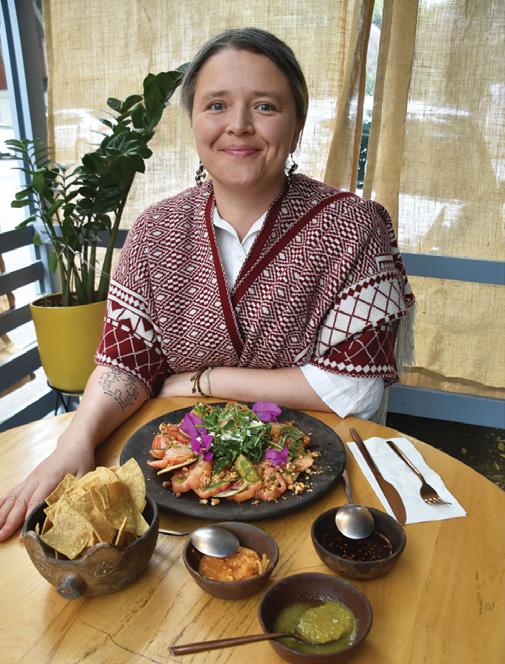
“The rst was Lagos de Moreno, located in Jalisco. Then I explored Tulpetlac, in Ecatepec,” López says, the latter the place of her childhood. Currently, the menu features dishes from Malinalco, a small pueblo in the state of Mexico.
“The menu for Malinalco will last for a year. Other [menus], six months, ten months. It depends,” Lopez says. “Next is Tabasco because it is a little-known state. People do not talk much about states in the center of Mexico. I would like to highlight this place and their food.”
When López decides to feature a region’s food, she lives in pueblos for months or, in the case of Lagos de Moreno, for a year and a half, learning culinary secrets from local women (and sometimes men). Back home, Mux remains open; no one person is left in charge because everyone knows their position and their work, she says.
Before she starts a deep dive into a region’s unique ingredients, recipes and preparation techniques, she performs a small ceremony.
“I ask permission of the universe,” says López. “It is to show respect for what I will learn. It is to inform the spirits that I will extract some information and food. It is also to ask for them to take care of me.”
from Mexico
Diana Lopez del Rio
Yellow Bean Tortitas with red adobo and fresh salad
She learns how to make the food several different ways. “I have been fortunate to meet very noble women who share this knowledge with me” she says. “I literally go out for a walk and ask, then they take me to other women, or they take me to other regions, other places where I discover new things. There are cooks that I go with to the market, and I cook with them. I always have a book with me, and I write down what they use and what they do.”
In Noxtepec in Mexico State, Lopez learned how to make very traditional tamales from a woman named Gloria Esmeralda Arellano Leonardes. She also learned to cook a “doughy” bean called frijol chino, which is very small and more acidic than most beans. “They’re not prepared using a blender and broth, as are most refritos, but are ground by hand,” Lopez explains.
In Malinalco, she learned recipes for moles and tamales from a woman named Agrícola — one of 31 traditional cooks in the state of Mexico registered with UNESCO and the Mexican Cuisine Conservatory. “She’s one of the most important traditional cooks in Malinalco and the head of four generations of cooks there,” Lopez says. The mole and tamales (made with mostly hand-ground ingredients) are now featured on Mux’s menu. At the end of her research, she makes an ofrenda of owers, corn and copal.
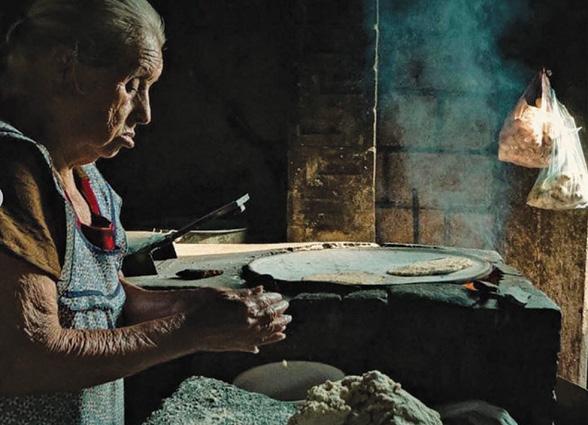
CRAFTING THE MENUS
Each menu at Mux gives a little history of the region and the food being featured, along with the name of the person who shared the recipe.
“I do not change the traditional recipes,” López says. There are times when she does change a recipe slightly, sometimes because an ingredient isn’t in season. “When I do change something, it is the history of the recipe that inspires me to add something.”
For the menu featuring foods of Malinalco, López has prepared a ve-course pairing menu that starts with drinks,
either alcoholic or non-alcoholic, followed by mini tacos lled with fruits; pork tamales; gorditas stuffed with fava beans; coffee and dessert. Food may also be ordered a la carte. There is a green mole, and a mole especial (typically only served at estas) made with walnuts, almonds, pine nuts and plantains — ingredients not used in mole that’s prepared daily.
As much as possible, Lopez uses cooking methods like those found in the pueblos.

“The two most important things in cocina Mexicana are cazuelas and rewood,” she explains. While much of the
The Impact of Tourism on Regional Cuisin
Malinalco has been designated by the Mexican government as a pueblo magico — a magic pueblo, one that has held onto its traditions. That designation has benefits — the pueblo attracts more tourists — but also drawbacks.
“The fact that it is a pueblo magico causes it to be invaded by tourism and gastronomic proposals that have nothing to do with local traditions and local gastronomy,” says Diana López del Rio, chef-owner of Mexico City’s Mux Restaurante. “Many traditional ingredients are being lost.”
For example, bananas, some herbs and spices, some types of corn, avocados and heirloom tomatoes have been mostly lost, according to Lopez. “There are still some people who grow them,” she said, “but not many.”
The same is true in other areas, too.
In Tulpetlac, Ecatepec, quelites, guava, avocados and limes are among items that are disappearing — “all lost due to urbanization,” she says.
JULY/AUGUST 2023 | el restaurante 55
“I have b n fortunate to m t v y noble women who share this knowledge with me. I lit a y go out for a walk and ask, then they take me to oth women, or they take me to oth regions, oth plac wh e I discov new things.”
DIANA LÓPEZ DEL RIO
food at Mux is cooked in cazuelas, the large, clay cooking pots, it’s simply not feasible to use rewood. The comal used to heat tortillas is made of black volcanic rock and the fava beans used to stuff the gorditas are ground with a hand grinder because using a blender gives the paste a slimy texture.
López isn’t trying to recreate recipes from centuries ago or some type of Pre-Hispanic cuisine. What she’s doing at Mux is documenting and preserving what’s presently happening in
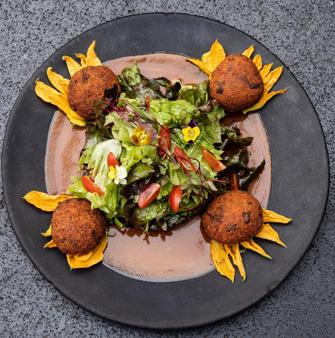
COCINA MEXICANA:
the cocina tradicional.
“In the cocina Mexicana, many of the dishes that they cook are recipes that are inherited,” she says. “They may cook it only for a particular esta. Cocina Mexicana is not in uenced so much by other countries. It is an everyday cocina. It is food of the pueblo, but not only in the pueblo. For example, in Mexico City, there are neighborhoods lled with people from one particular pueblo and they continue their traditions there. It is an inherited knowledge. This is the cocina tradicional. The cocina tradicional teaches. Girls learn from their mothers. They do not need a recipe to make the food because they watch.”
Crear alimentos que cuenten una hi oria
|
POR JOSEPH SORRENTINO, escribiendo desde México | “Se piensa que la cocina mexicana es la cocina del pueblo”, dice Diana López del Río, chef propietaria de Mux Restaurante, un restaurante

que abrió en la colonia Roma Norte de Ciudad de México hace dos años. “Muy pocos chefs y personas hablan de la la cocina mexicana. No se respeta como otros platos”.
El respeto por las tradiciones culinarias importantes es lo que López quería, y tras un viaje que dio algunos giros, es nalmente lo que ha conseguido en Mux.
López estudió gastronomía durante cinco años, de 2000 a 2005, en la Universidad del Claustro de Sor Juana en Ciudad de México, pero no estaba muy contenta con lo que aprendía.
“Solo te enseñan que la mejor cocina es la francesa, seguida de la italiana y la española”, dice. “Nunca hablaban ni incluían la
cocina mexicana”.
Después de abrirse camino en diversos trabajos de cocina —desde lavaplatos hasta chef de hotel— se dio cuenta que el barrio Roma estaba creciendo y decidió abrir un restaurante y llamarlo Mux.
“Mux signi ca ‘punto sagrado’ en mam, una lengua maya que está a punto de desaparecer”, dice, y explica que esa lengua se habla en parte de Guatemala y en algunos estados del sur de México.

from Mexico
Joseph Sorrentino is a Mexico-based freelance writer and frequent contributor to el Restaurante
Diana Lopez del Rio
Tortitas de frijol amarillo
Diana López del Rio
“También es un sonido que hacen [las mujeres] cuando machacan un metate”. El sonido más parecido en inglés sería algo así como “moosh”.
UNA INMERSIÓN EN LAS CULTURAS REGIONALES
Queriendo contar una historia a través de la comida que servía, López decidió centrarse en regiones o pueblos mexicanos determinados, presentando una zona cada vez.
“El primero fue Lagos de Moreno, situado en Jalisco. Luego exploré Tulpetlac, en Ecatepec”, dice López, este último el lugar de su infancia. Actualmente, el menú presenta platos de Malinalco, un pequeño pueblo del Estado de México.
“El menú de Malinalco durará un año. Otros [menús], seis meses, diez meses. Depende”, dice López. “El siguiente es Tabasco porque es un estado poco conocido. La gente no habla mucho de los estados del centro de México. Me gustaría destacar este lugar y su comida”.
Cuando López decide destacar la comida de una región, vive en los pueblos durante meses o, en el caso de Lagos de Moreno, durante año y medio, aprendiendo los secretos culinarios de las mujeres (y a veces de los hombres) locales. De vuelta a casa, Mux se man-
tiene abierta; no deja a nadie al mando porque todo el mundo conoce su puesto y su trabajo, dice.
Antes de iniciar una inmersión profunda en los ingredientes, recetas y técnicas de preparación únicos de una región, realiza una pequeña ceremonia.
“Pido permiso al universo”, dice López. “Es para mostrar respeto por lo que voy a aprender. Es para informar a los espíritus que voy a extraer algo de información y alimentos. También es
para pedirles que me cuiden”.
Aprende a preparar la comida de varias maneras diferentes. “He tenido la suerte de conocer a mujeres muy nobles que comparten estos conocimientos conmigo”, dice. “Salgo literalmente a pasear y pregunto, luego me llevan con otras mujeres, o me llevan a otras regiones, a otros lugares donde descubro cosas nuevas. Hay cocineras con las que voy al mercado y con las que cocino. Siempre llevo un libro conmigo y apunto lo que
del turismo en las cocinas regional Malinalco ha sido designado por el gobierno mexicano como pueblo mágico, uno que se ha aferrado a sus tradiciones. Esa designación tiene ventajas —el pueblo atrae a más turistas— pero también inconvenientes.

El
“El hecho que sea un pueblo mágico hace que se vea invadido por el turismo y por propuestas gastronómicas que nada tienen que ver con las tradiciones locales y la gastronomía local”, afirma Diana López del Río, chef propietaria del restaurante Mux de Ciudad de México. “Se están perdiendo muchos ingredientes tradicionales”.
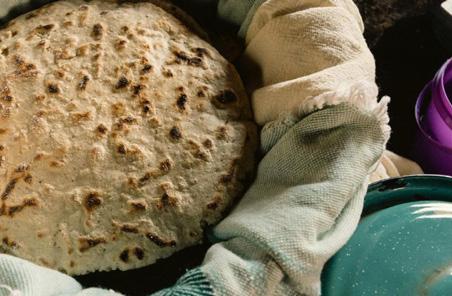
Por ejemplo, los plátanos, algunas hierbas y especias, algunos tipos de maíz, los aguacates y los tomates heirloom se han perdido en su mayoría, según López. “Todavía hay algunas personas que los cultivan”, dijo, “pero no muchas”.
Lo mismo ocurre en otras zonas. En Tulpetlac, Ecatepec, los quelites, la guayaba, los aguacates y las limas son algunos de los productos que están desapareciendo, “todos perdidos debido a la urbanización”, afirma.
“He tenido la su te de conoc muj muy nobl que comparten te conocimiento conmigo. Lit almente salgo a caminar y pregunto, luego me evan a otras muj , o me evan a otras region , a otros lugar donde d cubro cosas nuevas.”
DIANA LÓPEZ DEL RIO
efecto
JULY/AUGUST 2023 | el restaurante 57
utilizan y lo que hacen”.
En Noxtepec, en el Estado de México, López aprendió a hacer tamales muy tradicionales con una mujer llamada Gloria Esmeralda Arellano Leonardes. También aprendió a cocinar un frijol “pastoso” llamado frijol chino, que es muy pequeño y más ácido que la mayoría de los frijoles. “No se preparan con licuadora y caldo, como la mayoría de los refritos, sino que se muelen a mano”, explica López.
En Malinalco, aprendió las recetas de moles y tamales de una mujer llamada Agrícola, una de las 31 cocineras tradicionales del Estado de México registradas en la UNESCO y en el Conservatorio de la Cocina Mexicana. “Es una de las cocineras tradicionales más importantes de Malinalco y la cabeza de cuatro generaciones de cocineras de allí”, dice López. El mole y los tamales (elaborados en su mayoría con ingredientes molidos a mano) guran ahora en el menú de Mux.
Al nal de su investigación, hace una ofrenda de ores, maíz y copal.
ELABORAR LOS MENÚS
Cada menú de Mux ofrece un poco de historia de la región y de la comida que se presenta, junto con el nombre de la persona que compartió la receta.
“No cambio las recetas tradicionales”, dice López. Hay ocasiones en las que sí cambia ligeramente una receta, a veces porque un ingrediente no está de temporada. “Cuando cambio algo, es la historia de la receta la que me inspira a añadir algo”.
Para el menú con alimentos de Malinalco, López ha preparado un menú maridaje de cinco platos que comienza con bebidas, con o sin alcohol, seguidas de minitacos rellenos de frutas; tamales de cerdo; gorditas rellenas de habas; café y postre. La comida también puede pedirse a la carta. Hay un mole verde, y
un mole especial (que normalmente solo se sirve en las estas) hecho con nueces, almendras, piñones y plátanos, ingredientes que no se utilizan en el mole que se prepara a diario.
En la medida de lo posible, López utiliza métodos de cocina como los que se encuentran en los pueblos.
“Las dos cosas más importantes en la cocina mexicana son las cazuelas y la leña”, explica. Aunque gran parte de la comida en Mux se cocina en cazuelas, las grandes ollas de barro, no es factible utilizar leña. El comal que se utiliza para calentar las tortillas está hecho de roca volcánica negra y las habas con las que se rellenan las gorditas se muelen con un molinillo manual porque el uso de una batidora da a la pasta una textura viscosa.


López no está intentando recrear recetas de hace siglos ni algún tipo de cocina prehispánica. Lo que está haciendo en Mux es documentar y preservar lo que ocurre actualmente en la cocina tradicional.
“En la cocina mexicana, muchos de los platos que cocinan son recetas heredadas”, dice. “Puede que lo cocinen solo para una esta en particular. La cocina mexicana no está tan in uenciada por otros países. Es una cocina cotidiana. Es comida del pueblo, pero no solo en el pueblo. Por ejemplo, en Ciudad de México, hay barrios llenos de gente de un pueblo en particular y allí continúan con sus tradiciones. Es un conocimiento heredado. Es la cocina tradicional. La cocina tradicional enseña. Las niñas aprenden de sus madres. No necesitan una receta para hacer la comida porque observan”.
58 el restaurante | JULY/AUGUST 2023 from Mexico
Joseph Sorrentino es un escritor independiente afincado en México y colaborador habitual de el Restaurante.
BE&SCO Tamale Machines. Tamale Season is almost here — and BE&SCO offers the perfect solution to keep up with demand. Preparing tamales by hand is laborintensive and often creates inconsistent product. Our commercial-rated tamale machines, built to handle high production, o the perfect 60/40 (meat-to-masa ratio) consis tency! Whether you like más meat or más masa, BE&SCO has the perfect extruder variation to fit your preference! 210-734-5124; sales@bescomfg.com;bescomfg.com
Tamaleras de BE&SCO. La temporada de tamales ya casi está aquí, y BE&SCO ofrece la solución perfecta para satisfacer la demanda. Preparar tamales a mano requiere mucha mano de obra y, a menudo, crea un producto inconsistente. ¡Nuestras máquinas para tamales con calificación comercial, construidas para manejar una alta producción, ofrecen la consistencia perfecta de 60/40 (proporción de carne a masa)! Ya sea que le guste más carne o más masa, ¡BE&SCO tiene la variación de extrusora perfecta para satisfacer sus preferencias! 210-734-5124; sales@bescomfg.com;bescomfg.com
Better Earth Taco Clamshells. A convenient, eco-friendly solution for on-the-go tacos! Freezer-safe, soak-proof clamshells made of unbleached bamboo fiber are 100% compostable — no PFAs, wax, or plastic linings. becompostable.com
Conchas de taco de Better Earth. ¡Una solución conveniente y ecológica para tacos para llevar! Las conchas de almejas resistentes al congelador y al agua, hechas de fibra de bambú sin blanquear, son 100 % compostables, sin PFA, cera ni revestimientos de plástico. becompostable.com
Barfly® Mixology Gear Fine Mesh Spring Bar Strainer. This strainer combines the features of a spring bar strainer and a fine mesh strainer — lets bartenders double strain drinks without an additional step. Removes ice chips, fruit, and herbs from cocktails for a smooth and clean pour every time. barflybymercer.com
Colador de barra de resorte de malla fina de Barfly® Mixology Gear. Este colador combina las características de un colador de barra de resorte y un colador de malla fina: permite a los cantineros colar dos veces las bebidas sin un paso adicional. Elimina trozos de hielo, frutas y hierbas de los cócteles para un vertido suave y limpio en todo momento. barflybymercer.com


Don Diego Canned Vegetables. Get the quality your customers demand and the time- and labor-saving convenience your kitchen staff needs with canned tomatillos (grown, harvested and packaged in Mexico), Mexican-style hominy, chickpeas, jalapeños and more are available from Don Diego. dondiegoqualityfoods.com

Conservas Vegetales de Don Diego. Obtenga la calidad que exigen sus clientes y la conveniencia de ahorro de tiempo y mano de obra que su personal de cocina necesita con tomatillos enlatados (cultivados, cosechados y empacados en México), maíz estilo mexicano, garbanzos, jalapeños y más están disponibles de Don Diego. dondiegoqualityfoods.com
Contigo® Hot Sauces. Made with peppers grown and sourced in Mexico, these hot sauces come in flavors to fit any menu: Contigo Red Habanero, Contigo Green Habanero, Contigo Chile de Arbol, Contigo Poblano & Habanero, and a one-of-a-kind Contigo Hot Sauce for Seafood. performancefoodservice.com
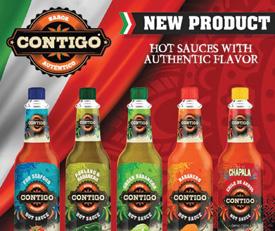
Salsas Picantes
Contigo®. Hechas con pimientos cultivados y obtenidos en México, estas salsas picantes vienen en sabores que se adaptan a cualquier menú: Contigo Red Habanero, Contigo Green Habanero, Contigo Chile de Arbol, Contigo Poblano & Habanero, y una salsa picante Contigo única en su tipo, para Mariscos. performancefoodservice.com
Chata Mexican Food. The Authentic Mexican Food Solution for you! Fully cooked, preservative-free Mexican dishes deliver unique homemade flavor. The line includes Chilorio de Cerdo, Cochinita Pibil, Chicharrón en Salsa Verde, Carnitas, Frijoles con Chorizo y Queso, Menudo Rojo, Pozole. Just open, heat and serve! Gerencia.exportaciones@chata.com.mx
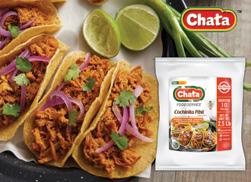
Chata Comida Mexicana. ¡La auténtica solución de comida mexicana para ti! Los platos mexicanos totalmente cocidos y sin conservantes brindan un sabor casero único. La línea incluye Chilorio de Cerdo, Cochinita Pibil, Chicharrón en Salsa Verde, Carnitas, Frijoles con Chorizo y Queso, Menudo Rojo, Pozole. ¡Solo abre, calienta y sirve! Gerencia. exportaciones@chata.com.mx

marketplace/el mercado
JULY/AUGUST 2023 | el restaurante 59
ZestoPro Motorized Citrus Zester. Save time and labor with this new kitchen tool that includes a heavy-duty rechargeable lithium-ion battery with enough run time to zest several dozen pieces of fruit. One-year warranty against manufacturing defects; 30-day money back guarantee. zestopro.com

Rallador de cítricos motorizado de ZestoPro. Ahorre tiempo y trabajo con esta nueva herramienta de cocina que incluye una batería de iones de litio recargable de alta resistencia con suficiente tiempo de funcionamiento para rallar varias docenas de frutas. Garantía de un año contra defectos de fabricación; 30 días de garantía de devolución de dinero. zestopro.com
Dyma Brands Vegan and Sugar-Free Condiments and Dressings. Customers have embraced vegan, plant-based, and sugar-free dining. O ffer what they’re looking for with Dyma Brands new Flavor Fresh Gourmet vegan and sugar-free products in singleserve pouches and cups unique to the foodservice space. Dymabrands.com
Condimentos y aderezos veganos y sin azúcar de Dyma Brands. Los clientes han adoptado comidas veganas, a base de plantas y sin azúcar. Ofrezca lo que están buscando con los nuevos productos veganos y sin azúcar Flavor Fresh Gourmet de Dyma Brands en bolsas y vasos de una sola porción exclusivos para el espacio de servicio de alimentos. Dymabrands.com

Margarita Man Frozen Cocktails. Boost profit margins with frozen margaritas and daiquiris made with Margarita Man mixes. Margarita machines, a network of frozen margarita machine rentals, and wholesale pricing available. Margaritaman.com

Cócteles helados de Margarita Man. Aumente los márgenes de ganancias con margaritas congeladas y daiquiris hechos con mezclas de Margarita Man. Máquinas para margaritas, una red de alquiler de máquinas para margaritas congeladas y precios al por mayor disponibles. Margaritaman.com
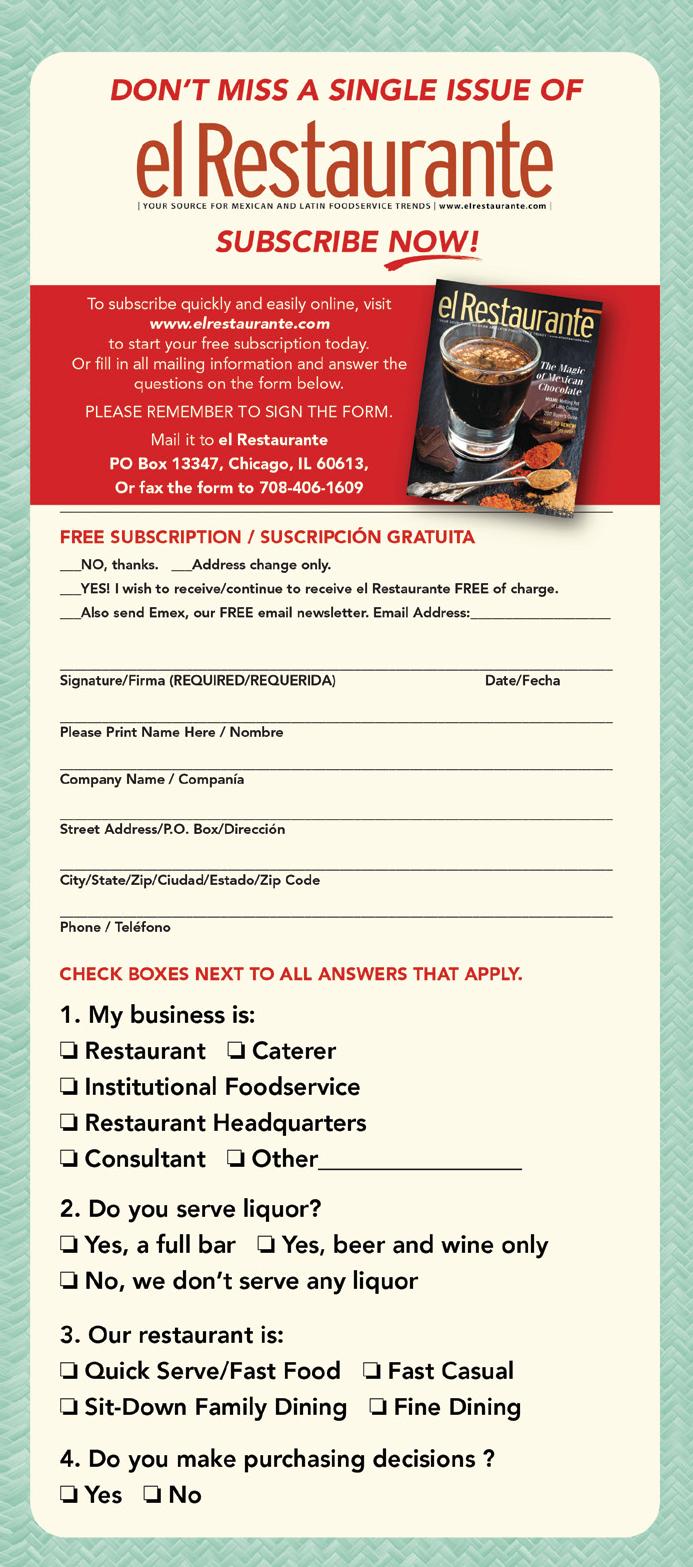
2023 marketplace/el mercado
Reach
SEPTEMBER/OCTOBER
• Cover Story: Side Dishes
• Business Basics: The Pros and Cons of Food Halls
• At the Bar: Creative Garnishes
• Ad Close: August 25
• Materials Due: August 31
•

NOVEMBER/DECEMBER
Our Annual Buyer’s Guide, with Special Offers for Advertisers!
• Cover Story: Tomatillos
• Special Report: 9th Annual Independent Mexican Restaurant Report

• Business Basics: Loyalty Cards and Subscriptions
• At the Bar: Wine and Spirits Storage
• Ad Close: October 27
• Materials Due: November 2
CALL PUBLISHER ED AVIS AT: 708-218-7755 to discuss how we can put el Restaurante to work for you.

A NEW OPPORTUNITY TO REACH OUR READERS!
These 3 digital-only issues will take a deep dive into topics of interest to anyone looking for ways to build their restaurant’s bottom line this year. Let our readers know your company can help them!
• SUMMER 2023: Technology
• FALL 2023: Wine and Beer
2 MORE GREAT ISSUES IN 2023 elRestaurante
2023
YOUR SOURCE FOR MEXICAN AND LATIN FOODSERVICE TRENDS
our 25,000+ readers with information about your products and services









resource guide Sign up for el Restaurante’s Recipe of the week email! EMAIL Kathy Furore, kfurore@restmex.com, with ‘Recipe’ In the subject line Over 50 years serving restaurants in the Northeast 62 el restaurante | JULY/AUGUST 2023
Arepa de coco: Coconut Arepa
Recipe from Arepas by Irena Stein
Makes 6 Arepas
1½ c. water, at room temperature
½ c. sugar cane syrup (1-to-1 sugar to water ratio)
1 t. salt
2 c. Harina P.A.N. pre-cooked white maize flour (cornmeal)
¾ c. grated (shredded) fresh coconut
Corn or vegetable oil, for deep frying
Combine water, sugar cane syrup and salt. Slowly add the maize flour and coconut with one hand while kneading the mixture with the other.
Once mixed, dough should be smooth. Leave to rest for 10 minutes before shaping the dough into 6 arepas.
To cook arepas: Pour enough vegetable oil to cover the arepas into a large heavy-based pan, making sure it is no more than ⅔ full. Heat oil to 320°F. Do not exceed this temperature as the arepas may burn.
Working in batches, carefully lower arepas into oil, avoiding splashes. Deep fry 4 to 5 minutes or until golden and crispy.
Remove from pan with slotted spoon. Place on baking tray lined with paper towels to absorb excess oil. Serve while hot.
Mexican Aperol Spritz
Recipe courtesy of Kavas Tacos + Tequila, Orlando, FL
1½ oz. Milagro blanco
1 oz. Aperol
3 oz. cava
1 oz. triple sec
Build in a wine glass and top with ice. Garnish with a clothespin, dehydrated orange and baby’s breath, or any edible flower.
Bartender’s Tip: Think about the colors of your final products when creating a flight. We happen to love a variety of colors, so this was one of the main focuses of our cocktail tree.
Raspado Cocktail Flight
All recipes courtesy of Gracias Madre, Los Angeles
Build each Raspado in a rocks glass, or in a biodegradable 12-oz. plastic cup for the extra Mexican street food vibes.
Raspado
Guava
Seasonal fruit (we normally use strawberries and blueberries)
Shaved ice
1½ oz. Pajarote Guava Ponche
1½ oz. Herradura Blanco Tequila
1 oz. lime cordial (recipe below)
Chamoy (recipe top right)
Put fruit on the bottom of the glass. Top with shaved ice, packed lightly to make a base for the ice scoop ball.
Combine the ponche, tequila and lime cordial and pour into the glass. Stir the contents of the glass to help combine the ice into the liquid. Using a 4-oz. ice cream scoop, create an ice ball with the shaved ice.
Release the ice ball and place on top of packed ice in the glass. Pipe about 2 ounces of chamoy on top or until ice ball is saturated. Garnish with a plush of mint, a straw and a spoon.
The Lime Cordial: Makes approximately 1 liter
500 ml lime juice
440 g agave nectar
20 g lime peels
10 g orange peel
18 g lime acid
2 g salt
Combine Ingredients. Sous Vide at 145°F for 2 hours. Fine strain. Store in refrigerator. Shelf life is about one month.
The Chamoy: Makes about 1 liter
500 g frozen cranberries
140 g apricot jam
140 g agave nectar
500 ml water
500 ml lime juice
4 g salt
8 g chipotle powder
Blend all ingredients on high for 4 minutes. Fine strain to remove cranberry skins. Store in refrigerator. Shelf life is about one month.
Raspado Watermelon
1½ oz. La Tierra De Acre Cenizo
Mezcal
1 oz. watermelon/mint syrup (recipe below)
½ oz. Cointreau
¼ oz. lemon juice
2 full droppers Pink Peppercorn Tincture (recipe below)
Shaved ice
Pineapple popsicle (recipe below)
Spicy salt (house-made or Tajin)
Mint for garnish
Combine first five ingredients in a rocks glass. Fill with shaved ice. Stir the contents of the glass to help combine the ice into the liquid. Add more shaved ice if needed. Remove a pineapple popsicle from the mold and sprinkle with spicy salt on one side. Place popsicle on top. Garnish with a plush of mint, a straw and a spoon.
The Watermelon/Mint Syrup: Makes 500 ml
250 ml watermelon juice
250 g sugar
7 g mint
Blend watermelon and sugar only to combine. Add mint to liquid. Store in the fridge for 24 hours. Strain out mint before use. Store in refrigerator. Shelf life is about one month.
The Pink Peppercorn Tincture: 10 g pink peppercorn
240 ml high proof spirit (Everclear)
Combine in a dropper bottle. Infuse for at least 48 hours before using.
The Pineapple Popsicle: Add pineapple juice to mold ¾ full. Freeze 12 hours. Fill the remaining ¼ of the mold with chamoy. Freeze 12 hours.
Raspado Cacao
1½ oz. El Tequileno Reposado
½ oz. 1:1 date syrup (recipe below)
¼ oz. Tempus Fugit Creme De Cacao
¼ oz. Mr. Black Coffee Liqueur
1 barspoon Pajarote Clove (or Allspice dram)
Shaved ice
1 scoop vanilla ice cream
Dark chocolate, shaved, for garnish
Mint, for garnish
Combine first five ingredients in a rocks glass with 3 to 4 cubes of ice to make a foundation for the shaved ice and ice cream.
Top with shaved ice, then with a scoop of vanilla ice cream. Garnish with shaved dark chocolate, a plush of mint, a spoon and a straw.
The Date Syrup:
500 g date syrup
500 ml hot water
Combine in a heat safe container. Stir to combine. Store in refrigerator. Shelf life is about one month.
recipes
JULY/AUGUST 2023 | el restaurante 63
SEE MORE GREAT RECIPES FOR ALL CATEGORIES ON YOUR MENU AT elrestaurante.com/recipes.
Chris Morelli TACO SHOP
UNIQUE
TACOS ARE THE
CALLING CARD AT TACO SHOP , the restaurant Chris Morelli and business partner Santiago Reyes opened four years ago in El Paso, Texas. As Morelli describes it, the spot is different “in every aspect from your traditional taquero — our restaurant is literally one of a kind serving up some unique tacos in the borderland.”
Those tacos — developed after the two business partners traveled throughout the United States and Mexico “to nd the perfect combinations for our tacos” — include options made with exotic meats including kangaroo, stingray, chapulines (crickets), birria de chivo (goat), alligator, armadillo and more.
As popular and unique as the tacos are, it is the Vegan Dragon Fruit Arroz Con Leche that Morelli named as a favorite that he wanted to share. It’s a dessert as unique as the tacos themselves, and one that has become a Taco Shop staple.
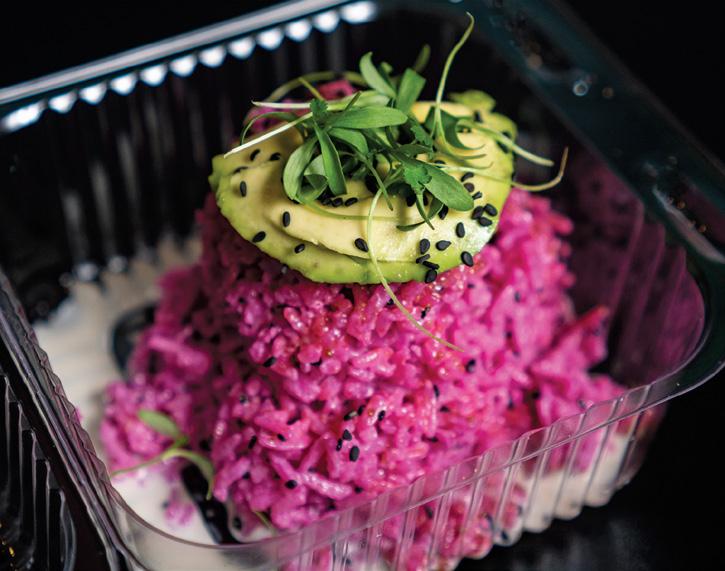
“We came up with our Vegan Dragon Fruit Arroz Con Leche after realizing we needed a unique dessert feature on our menu. We didn’t want to stay too traditional, but we also didn’t want to go way off the deep end with a complex dessert,” Morelli explains. “We wanted everyone to be able to try this dish and we know we have a big vegan crowd that enjoys eating at our restaurant — so we made sure not to leave anyone out. The sweetness of the dragon fruit and creamy texture of oat milk just works.”
Morelli goes on to offer his personal tips for preparing the dessert.
“You can use any plant milk of your choice, but we found that oat milk was the best. And you can add fresh fruit, orange zest, dried fruit, nutmeg, etc. for added avor,” Morelli says, noting that Taco Shop decided to use short-grain rice because of the creamy texture it imparts.
DRAGON FRUIT ARROZ CON LECHE
2 c. short grain rice
1 Ceylon cinnamon stick
2 -inch
3 c. water
4 c. vanilla oat milk
2 oz. vanilla bean extract
½ - 1 c. vegan sugar
1 c. vegan condensed milk
1 c. vegan dulce de leche
2 c. frozen dragon fruit cubes
2 oz. black sesame seeds
Fresh avocado slices and micro radish, for garnish
In a large pot combine water, cinnamon stick, and rice. Bring water to a simmer and simmer slowly for 15 minutes.
Add oat milk, condensed milk and dulce de leche to the pot and simmer for 10 more minutes.
Add ½ - 1 cup of the sugar (depending on desired sweetness) and vanilla, simmer for another 10 minutes or until the arroz con leche has reached the right consistency. Remove from the heat, add dragon fruit and sesame seeds; let the rice cool slightly. It will thicken as it cools.
Sprinkle with ground cinnamon before serving. Refrigerate. Serve chilled, garnished with micro radish and fresh avocado slices.
my favorite recipe



today for samples of our authentic Al Pastor, Pollo Adobo and Carne Asada. Available in Trompos (hand-stacked cones) and cooked-to-order IQF Strips that provide maximum flavor, yield and portion control.
Serve Delicious Authentic Tacos EVERY DAY! Ask your favorite distributor for Mega Sabor products.
Call
Now






































































































































































































 Paola Ortega is a freelance writer based in Chicago and a new contributor to el Restaurante
Paola Ortega is a freelance writer based in Chicago and a new contributor to el Restaurante




 | BY MAXIMILIANO D’ONOFRIO |
| BY MAXIMILIANO D’ONOFRIO |










































 | BY JOSEPH SORRENTINO,
| BY JOSEPH SORRENTINO,


































